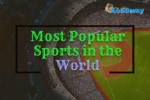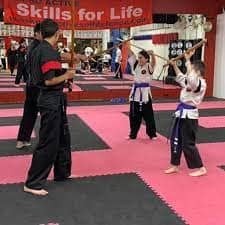List of 184 Martial Arts
Bataireacht
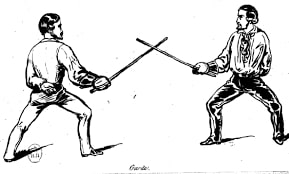
In Irish martial arts, bataireacht (pronounced [ˈbˠat̪ˠəɾʲaxt̪ˠ]; meaning ‘stick-fighting’) or boiscín are the various forms of stick-fighting from Ireland.
Read More About Bataireacht / Source
Gatka
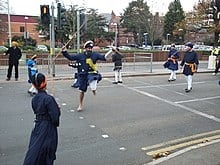
Gatka (Gurmukhi: ਗਤਕਾ; Shahmukhi: گَتکا; Hindi: गतका;Urdu: گَتکا) is a form of martial art associated primarily with the Sikhs of the Punjab and other related ethnic groups, such as Hindkowans. It is a style of stick-fighting, with wooden sticks intended to simulate swords. The Punjabi name, gatka, refers to the wooden stick used and this term might have originated as a diminutive of Sanskrit word, “gada”, meaning mace.The stick used in Gatka is made up of wood and is usually 3 to 3.5 feet long with a thickness of around half an inch. It comes with a leather fitted hilt (6 to 7 inches long) and is often decorated with Punjabi style multi-coloured threads.The other weapon used in the sport is a shield, natively known as Phari. It is round in shape, measuring 9×9 inches, and is made of dry leather. It is filled with either cotton or dry grass to protect the hand of player in case of full contact hit of the opponent.Gatka originated in the Punjab in the 15th century, but much of the Gatka forms practiced today in the west are Europeanised versions of what was the original martial art of Sikhs known as Shastar Vidya. There has been a revival during the later 20th century, with an International Gatka Federation was founded in 1982 and formalized in 1987, and gatka is now popular as a sport or sword dance performance art and is often shown during Sikh festivals.
Read More About Gatka / Source
Bokator
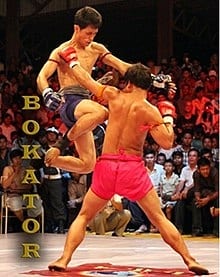
Bokator is an ancient battlefield martial art used by ancient Khmer military groups. It is one of the oldest existing fighting systems originating from Cambodia.Oral tradition indicates that bokator (or an early form thereof) was the close quarter combat system used by the ancient Cambodian armies before the founding of Angkor. A common misconception is that bokator refers to all Khmer/Cambodian martial arts, while in reality it only represents one particular style.
Read More About Bokator / Source
Danzan Ryu
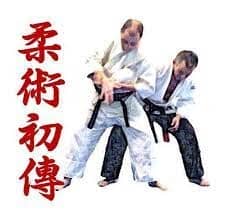
Danzan-ryū (檀山流) is a ryū of jujutsu founded by Seishiro Okazaki (1890–1951) in Hawaii. Danzan-ryū jujutsu is of mainly Japanese origin but is most common in the West coast of the United States. The Danzan-ryū syllabus is syncretic, and includes non-Japanese elements.
Read More About Danzan Ryu / Source
Angampora
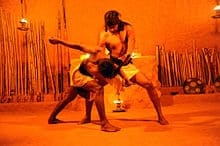
Angampora is a Sri Lankan martial art that combines combat techniques, self-defense, sport, exercise, and meditation. A key component of angampora is the namesake angam, which incorporates hand-to-hand fighting, and illangam, involving the use of indigenous weapons such as the ethunu kaduwa, staves, knives and swords. Another component known as maya angam, which uses spells and incantations for combat, is also said to have existed. Angampora’s distinct feature lies in the use of pressure point attacks to inflict pain or permanently paralyze the opponent. Fighters usually make use of both striking and grappling techniques, and fight until the opponent is caught in a submission lock that they cannot escape. Usage of weapons is discretionary. Perimeters of fighting are defined in advance, and in some of the cases is a pit.With the advent of colonialism over the entirety of the island in 1815, Angampora fell into disuse and was very nearly lost as a part of the country’s heritage. The British administration prohibited its practice due to the dangers posed by a civilian populace versed in a martial art, burning down any angan madu (practice huts devoted to the martial art) found: flouting of the law was punished by a gunshot to the knee, effectively crippling practitioners; Angampora nevertheless survived within a few families, allowing it to emerge into mainstream Sri Lankan culture post-independence.A number of paintings related to angampora are found at Buddhist temples in Sri Lanka. These include Embekka Devalaya, Gadaladeniya Rajamaha Viharaya, Temple of the Tooth, Saman Devalaya (Ratnapura) and Lankathilaka Rajamaha Viharaya.
Read More About Angampora / Source
Araki Ryu
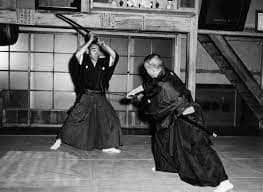
Araki-ryū (荒木流) is a Japanese koryū martial art founded during the Sengoku jidai by Araki Mujinsai Minamoto no Hidenawa (荒木夢仁斎源秀縄). Araki-ryu is a comprehensive system that specializes in the use and application of many traditional Japanese weapons such as spear, glaive, long and short sword, staff, rope, chain and sickle, and torite-kogusoku (grappling in light armor with weapons).
Read More About Araki Ryu / Source
Bando
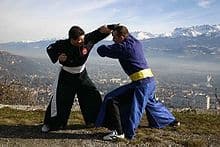
Bando (Burmese: ဗန်တို, pronounced [bàɰ̃dò]) is a defensive unarmed martial art from Myanmar. Bando is sometimes mistakenly used as a generic word for all Burmese martial arts, but it is only one martial art; Burmese fighting systems collectively are referred to as thaing.
Read More About Bando / Source
Choi Kwang -Do
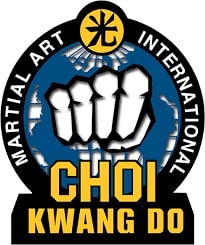
Choi Kwang Do is a martial art developed by Choi Kwang-jo. The style relies more on flexibility and fluidity of movement as opposed to the more rigid lines of some other martial arts. To achieve this it employs yoga-based stretching to develop the flexibility of practitioners.
Read More About Choi Kwang -Do / Source
Karate
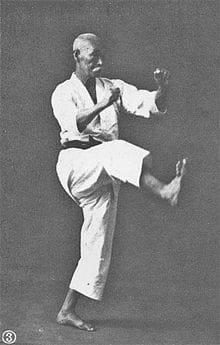
Karate (空手) (; Japanese pronunciation: [kaɾate] (listen); Okinawan pronunciation: [kaɽati]) is a martial art developed in the Ryukyu Kingdom. It developed from the indigenous Ryukyuan martial arts (called te (手), “hand”; tii in Okinawan) under the influence of Chinese martial arts, particularly Fujian White Crane. Karate is now predominantly a striking art using punching, kicking, knee strikes, elbow strikes and open-hand techniques such as knife-hands, spear-hands and palm-heel strikes. Historically, and in some modern styles, grappling, throws, joint locks, restraints and vital-point strikes are also taught. A karate practitioner is called a karateka (空手家).
The Empire of Japan annexed the Ryukyu Kingdom in 1879. Karate came to mainland Japan in the early 20th century during a time of migration as Ryukyuans, especially from Okinawa, looked for work in the main islands of Japan. It was systematically taught in Japan after the Taishō era of 1912–1926. In 1922 the Japanese Ministry of Education invited Gichin Funakoshi to Tokyo to give a karate demonstration. In 1924 Keio University established the first university karate club in mainland Japan, and by 1932 major Japanese universities had karate clubs. In this era of escalating Japanese militarism, the name was changed from 唐手 (“Chinese hand” or “Tang hand”) to 空手 (“empty hand”) – both of which are pronounced karate in Japanese – to indicate that the Japanese wished to develop the combat form in Japanese style. After World War II, Okinawa became (1945) an important United States military site and karate became popular among servicemen stationed there.The martial arts movies of the 1960s and 1970s served to greatly increase the popularity of martial arts around the world, and English-speakers began to use the word karate in a generic way to refer to all striking-based Asian martial arts. Karate schools began appearing around the world, catering to those with casual interest as well as those seeking a deeper study of the art.
Shigeru Egami, Chief Instructor of the Shotokan dōjō, opined that “the majority of followers of karate in overseas countries pursue karate only for its fighting techniques … Movies and television … depict karate as a mysterious way of fighting capable of causing death or injury with a single blow … the mass media present a pseudo art far from the real thing.” Shōshin Nagamine said: “Karate may be considered as the conflict within oneself or as a life-long marathon which can be won only through self-discipline, hard training and one’s own creative efforts.”On 28 September 2015 karate featured on a shortlist (along with baseball, softball, skateboarding, surfing, and sport climbing) for consideration for inclusion in the 2020 Summer Olympics. On 1 June 2016 the International Olympic Committee’s executive board announced they were supporting the inclusion of all five sports (counting baseball and softball as only one sport) for inclusion in the 2020 Games.
Web Japan (sponsored by the Japanese Ministry of Foreign Affairs) claims that karate has 50 million practitioners worldwide, while the World Karate Federation claims there are 100 million practitioners around the world.
Read More About Karate / Source
Ninjutsu

Ninjutsu (忍術), sometimes used interchangeably with the modern term ninpō (忍法), is the strategy and tactics of unconventional warfare, guerrilla warfare and espionage purportedly practised by the ninja. Ninjutsu was a separate discipline in some traditional Japanese schools, which integrated study of more conventional martial arts (taijutsu) along with shurikenjutsu, kenjutsu, sōjutsu, bōjutsu and others.
While there is an international martial arts organization representing several modern styles of ninjutsu, the historical lineage of these styles is disputed. Some schools claim to be the only legitimate heir of the art, but ninjutsu is not centralized like modernized martial arts such as judo or karate. Togakure-ryū claims to be the oldest recorded form of ninjutsu, and claims to have survived past the 16th century.
Read More About Ninjutsu / Source
American Kenpo
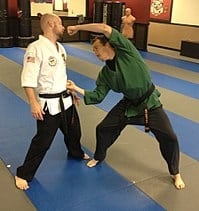
American Kenpo Karate (), also known as American Kenpo and Kenpo Karate, is an updated system of martial arts based on modern-day street fighting that applies logic and practicality. It is characterized by the use of quick and powerful strikes delivered from all of the body’s natural weapons, powered by rapid stance transitions, called “shifting.” Beginners are introduced to basic attack responses, which comprise a larger system taught through scripted scenarios, which allow instructors a platform to share concepts and principles Ed Parker emphasized in his teachings.
The purpose of training in this manner is to increase physical coordination and continuity with linear and circular motion. Each movement, when correctly executed, leads into the next, keeping an adversary’s “dimensional zone” in check, while limiting their ability to retaliate. Should the adversary not react as anticipated, the skilled Kenpo practitioner, it is argued, is able to seamlessly transition into an alternative and appropriate action, drawn spontaneously from the trained subconscious.Founded and codified by Ed Parker, American Kenpo is primarily a self-defense combat system. Parker made significant modifications to the original art of Kenpo which he learned throughout his life, by introducing or changing principles, theories, and concepts of motion, as well as terminology. At the time of his passing in December 1990, Parker had created Short Form 1, Long Form 1, Short Form 2, Long Form 2, Short Form 3, Long Form 3, Long Form 4, Long Form 5 (Surprise Attacks), Long Form 6 (Bare Hands vs. Weapons), Long Form 7 (Twin Clubs), and Long Form 8 (Twin Knives). Parker also created 154 named (ideal phase) technique sequences with 96 extensions, taught in three phases (Ideal, What-if and Formulation Phases). Parker believed in tailoring Kenpo to the individual and would also encourage his students to explore the unknown areas of martial arts.
Parker left behind a large following of instructors who honored his teachings by implementing many different versions of American Kenpo. As Senior Grandmaster, Parker did not name a successor to his art, but instead entrusted his senior students to continue his teachings in their own way.
Read More About American Kenpo / Source
Bojuka
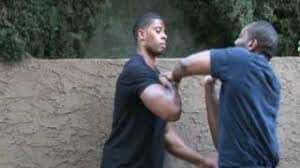
Bojuka is a self defense system. Training emphasizes simple techniques using common gross motor skills that are maintained under stressful conditions. Bojuka teaches threat elimination through awareness, avoidance, and the reasonable use of force.
Read More About Bojuka / Source
Budo
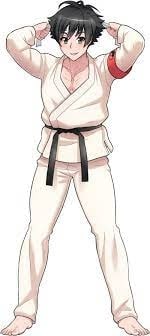
Budō (武道) is a Japanese term describing modern Japanese martial arts. Literally translated it means the “Martial Way”, and may be thought of as the “Way of War” or the “Way of Martial Arts”.
Catch wrestling

Catch wrestling (originally Catch-as-catch-can) is a classical hybrid grappling style and combat sport. It was developed by J. G. Chambers in Britain c. 1870. It was popularised by wrestlers of travelling funfairs who developed their own submission holds, or “hooks”, into their wrestling to increase their effectiveness against their opponents. Catch wrestling derives from various different international styles of wrestling: several English styles (primarily Lancashire, as well as Cumberland and Westmorland wrestling and Devonshire, Indian pehlwani, and Irish collar-and-elbow wrestling). The training of some modern submission wrestlers, professional wrestlers and mixed martial artists is founded in catch wrestling.
Professional wrestling, once a legitimate combat sport, was competitive catch wrestling. The original and historic World Heavyweight Wrestling Championship was created in 1905 to identify the best catch as catch can wrestler in the world, before the belt was retired in 1957 and unified with the NWA World Heavyweight Championship. Modern day professional wrestling has its origins in catch wrestling exhibitions at carnivals where predetermined (“worked”) matches had elements of performing arts introduced (as well as striking and acrobatic maneuvers), turning it into an entertainment spectacle.Catch-as-catch-can was included in the 1904 Olympic Games, it had new rules and weight categories introduced similar to other amateur wrestling styles, and dangerous moves — including all submission holds — were banned. New rules and regulations were later developed and codified by FILA and amateur catch wrestling became known as freestyle wrestling, which was then considered separate from the dangerous, professional catch style.Other martial arts with origins in catch wrestling include folkstyle wrestling, Sambo, Luta Livre, shoot-style, shootfighting and mixed martial arts (MMA).
Read More About Catch wrestling / Source
Correda
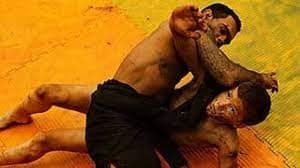
Coreeda is a style of folk wrestling practiced in Australia and is based on Aboriginal combat sports that existed in the pre-colonial period before the 19th century.
Read More About Correda / Source
Cuong Nhu

Cuong Nhu Martial Arts Association is a federally recognized non-profit educational organization. Cuong Nhu is a martial art that blends the basic elements of a number of different styles. Cuong Nhu has its roots in Shotokan Karate and combines aspects of Aikido, Judo, Wing Chun, Vovinam, Tai Chi Chuan, and Boxing.
Read More About Cuong Nhu / Source
Daido Juku Kudo
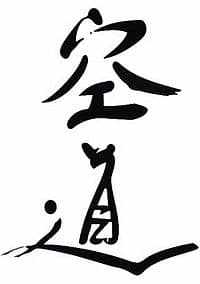
Kūdō (空道, Kūdō) is a Japanese hybrid martial art.
It is a full-contact combat sport that aims to achieve both safety and practicality, a style of mixed martial arts practised with headgear and gloves. It features stand-up striking, with throwing and grappling techniques being also allowed in the competition, including restraint, locks and chokeholds.Daido Juku is an organization founded by Azuma Takashi in 1981.
Kudo has more than 100 locations in Japan and is practised in more than 50 countries around the world. Although it is a martial art created by the Japanese, Russia currently has the largest number of Kudo athletes, eclipsing the number of Japanese practitioners.
Read More About Daido Juku Kudo / Source
Jeet Kune Do
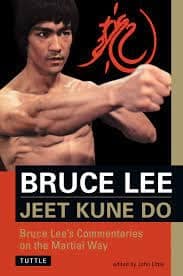
Jeet Kune Do is a hybrid martial art heavily influenced and adapted by the personal philosophy and experiences of martial artist Bruce Lee.
Read More About Jeet Kune Do / Source
Judo
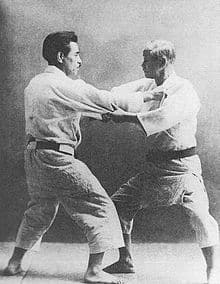
Judo (柔道, lit. “gentle way”) is a system of unarmed combat, modern Japanese martial art and Olympic sport (since 1964). Judo was created in 1882 by Jigoro Kano (嘉納治五郎) as an eclectic martial art, distinguishing itself from its predecessors (primarily Tenjin Shinyo-ryu jujutsu and Kitō-ryū jujutsu) due to an emphasis on “randori” (乱取り, lit. free sparring) instead of “kata” (pre-arranged forms) alongside its removal of striking and weapon training elements. Judo rose to prominence for its dominance over established jujutsu schools in tournaments hosted by the Tokyo Metropolitan Police Department (警視庁武術大会, Keishicho Bujutsu Taikai), resulting in its adoption as the department’s primary martial art. As “jujutsu” was a Japanese term referring to this sub-type of martial arts in general, Judo was colloquially known as Kano Jujutsu or Kano Ryu (lit. “Kano’s style of jujutsu) to differentiate it from other jujutsu schools; this naming convention decreased in prominence due to the adoption of the formal name of Judo. A judo practitioner is called a “judoka”, and the judo uniform is called “judogi”.
The objective of competitive judo is to throw an opponent, immobilize them with a pin, or force an opponent to submit with a joint lock or a choke. While strikes and use of weapons are included in some pre-arranged forms (kata), they are not frequently trained and are illegal in judo competition or free practice. Judo’s international governing body is the International Judo Federation, and competitors compete in the international IJF professional circuit.
Judo’s philosophy revolves around 2 primary principles: “Seiryoku-Zenyo” (精力善用 lit. maximum efficient use of energy) and “Jita-Kyoei” (自他共栄, lit. mutual welfare and benefit). The philosophy and subsequent pedagogy developed for judo became the model for other modern Japanese martial arts that developed from koryū (古流, traditional schools). Judo also spawned a number of derivative martial arts around the world, such as Brazilian jiu-jitsu, Krav Maga, Sambo and ARB. Judo also influenced other combat styles such as close-quarters combat (CQC), mixed martial arts (MMA), shoot wrestling and submission wrestling.
Kendo
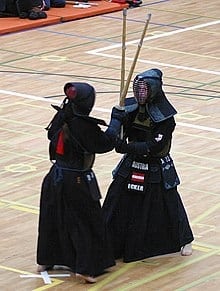
Kendo (剣道, Kendō, lit. ‘sword way’, ‘sword path’ or ‘way of the sword’) is a modern Japanese martial art, descended from kenjutsu (one of old Japanese martial arts, swordsmanship), that uses bamboo swords (shinai) as well as protective armor (bōgu). Today, it is widely practiced within Japan and has spread to many other nations across the world.
Kendo is an activity that combines martial arts practices and values with strenuous, sport-like physical activity.
Read More About Kendo / Source
Sikaran
Sikaran is a Filipino Martial Art that involves hand and mostly foot fighting.
As Sikaran is a general term for kicking which is also used as the name of the kicking aspects of other Filipino Martial arts, this article discusses the distinct art which is specifically practiced in the Rizal province that focuses almost exclusively in kicking.
Read More About Sikaran / Source
Teukgong Moosool
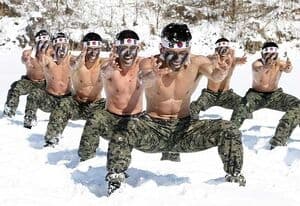
Teukgong Moosool (TGMS) is a martial art originating from South Korea. It is the official martial art practiced by the South Korean Special Forces. TGMS is a combative method of fighting as opposed to a sport. It emphasis the rapid interdiction and submission of an opponent. TGMS has been adapted beyond the special forces, for practice by bodyguards, police and law enforcement personnel and individuals interested in an effective method of self-defense.
Read More About Teukgong Moosool / Source
Thang-Ta
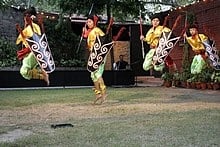
Huyen langlon is an Indian martial art from Manipur. In the Meitei language, huyen means war while langlon or langlong can mean net, knowledge or art. Huyen langlon consists of two main components: thang-ta (armed combat) and sarit sarak (unarmed fighting). The primary weapons of huyen langlon are the thang (sword) and ta (spear). The spear can be used in its non-missile form while in close or thrown from afar. Other weapons include the shield and the axe. Unarmed combat incorporates hand strikes, kicks, and grappling (mukna). Because of Manipur’s cultural similarity and geographical proximity with Myanmar, huyen langlon is closely related to Burmese bando and banshay.
The thang-ta aspect of huyen langlon can be practiced in three ways: ritual, demonstration, and combat. The first way is related to tantric practices and is entirely ritualistic in nature. The second way consists of a spectacular performance involving sword and spear dances. These routines can be converted into actual fighting practices. The third way is the true combat application.
Thang-ta shares a connection with certain war-dances, often blurring the line between dance and combat forms, such as thangkairol (sword dance) and khosarol (spear dance). Many ritualistic dances in Manipur were traditionally performed by martial artists such as the spear dance for funerals or the sacred thengou dance. The sword movements in dance are meant to either symbolize protection or to ward off evil spirits.
Read More About Thang-Ta / Source
Yongmudo

Yongmudo, Yongmoodo or Yong Moo Do (Korean: 용무도) is a modern hybrid Korean martial art which combines different techniques from taekwondo, hapkido, judo, and ssireum as well as boxing and wrestling.
Read More About Yongmudo / Source
Boxing
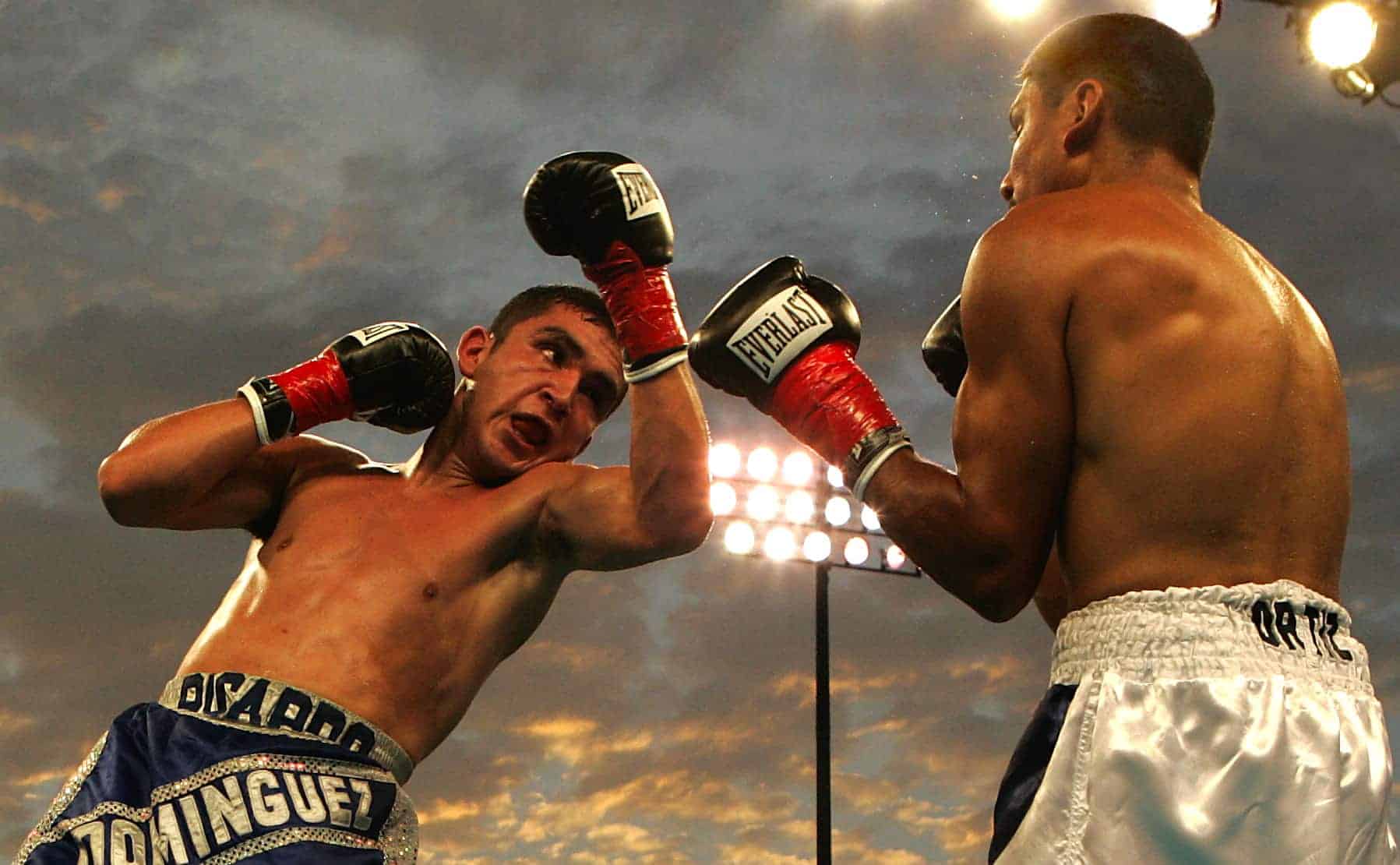
Boxing is a combat sport in which two people, usually wearing protective gloves, throw punches at each other for a predetermined amount of time in a boxing ring.
Amateur boxing is both an Olympic and Commonwealth Games sport and is a standard fixture in most international games—it also has its own World Championships. Boxing is overseen by a referee over a series of one-to-three-minute intervals called rounds.
A winner can be resolved before the completion of the rounds when a referee deems an opponent incapable of continuing, disqualification of an opponent, or resignation of an opponent. When the fight reaches the end of its final round with both opponents still standing, the judges’ scorecards determine the victor. In the event that both fighters gain equal scores from the judges, professional bouts are considered a draw. In Olympic boxing, because a winner must be declared, judges award the contest to one fighter on technical criteria.
While humans have fought in hand-to-hand combat since the dawn of human history, the earliest evidence of fist-fighting sporting contests date back to the ancient Near East in the 3rd and 2nd millennia BC. The earliest evidence of boxing rules date back to Ancient Greece, where boxing was established as an Olympic game in 688 BC. Boxing evolved from 16th- and 18th-century prizefights, largely in Great Britain, to the forerunner of modern boxing in the mid-19th century with the 1867 introduction of the Marquess of Queensberry Rules.
Read More About Boxing / Source
Aikijujutsu
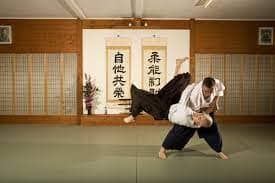
Daitō-ryū Aiki-jūjutsu (大東流 合気柔術), originally called Daitō-ryū Jujutsu (大東流柔術, Daitō-ryū Jūjutsu), is a Japanese martial art that first became widely known in the early 20th century under the headmastership of Takeda Sōkaku. Takeda had extensive training in several martial arts (including Kashima Shinden Jikishinkage-ryū and Sumo) and referred to the style he taught as “Daitō-ryū” (literally, “Great Eastern School”). Although the school’s traditions claim to extend back centuries in Japanese history there are no known extant records regarding the ryū before Takeda. Whether Takeda is regarded as either the restorer or the founder of the art, the known history of Daitō-ryū begins with him. Takeda’s best-known student was Morihei Ueshiba, the founder of Aikido.
Read More About Aikijujutsu / Source
Budokan
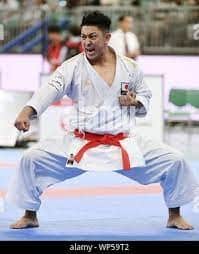
Nippon Budokan (日本武道館, Nippon Budōkan), often shortened to simply Budokan, is an indoor arena located in Chiyoda, Tokyo, Japan. Originally built for the inaugural Olympic judo competition in the 1964 Summer Olympics, its name translates as Martial Arts Hall in English. While its primary purpose is to host martial arts contests, the arena has gained additional fame as one of the world’s most iconic musical performance venues. Budokan was a popular venue for Japanese professional wrestling for a time, and it has hosted numerous other sporting events such as the 1967 Women’s Volleyball World Championship. Most recently, the arena hosted the Olympic debut of karate in the 2020 Summer Olympics as well
as the judo competition at both the 2020 Summer Olympics and the 2020 Summer Paralympics.
A number of famous rock music acts have played at Budokan. The Beatles were the first rock group to play there in a series of concerts held between June 30 and July 2, 1966. ABBA ended their last tour there. Their final show on March 27, 1980, was the last live concert ABBA performed together. Numerous acts have recorded live albums at Budokan, including Blur, Bryan Adams, Bob Dylan, Eric Clapton, Cheap Trick, Dream Theater, Duran Duran, Kiss, Mr. Big, Ozzy Osbourne, Judas Priest, Paul McCartney, Ringo Starr, Journey and Deep Purple.
Read More About Budokan / Source
Dutch Kickboxing
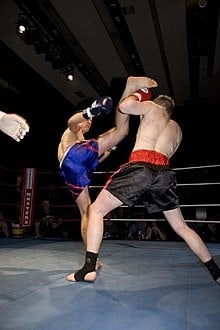
Kickboxing is a group of stand-up combat sports based on kicking and punching, historically developed from karate mixed with boxing, with Taekwondo, Muay Thai, and Savate also having some influence. Kickboxing is practiced for self-defence, general fitness, or as a contact sport.Japanese kickboxing originated in the late 1950s, with competitions held since then. American kickboxing originated in the 1970s and was brought to prominence in September 1974, when the Professional Karate Association (PKA) held the first World Championships. Historically, kickboxing can be considered a hybrid martial art formed from the combination of elements of various traditional styles. This approach became increasingly popular since the 1970s, and since the 1990s, kickboxing has contributed to the emergence of mixed martial arts via further hybridization with ground fighting techniques from Brazilian jiu-jitsu, and folk wrestling.
There is no single international governing body. International governing bodies include the World Association of Kickboxing Organizations (also known as WAKO), World Kickboxing Association, International Sport Karate Association, International Kickboxing Federation, and World Kickboxing Network, among others. Consequently, there is no single kickboxing world championship, and champion titles are issued by individual promotions, such as Glory, ONE Championship, K-1, SUPERKOMBAT and Kunlun Fight among others. Bouts organized under different governing bodies apply different rules, such as allowing the use of knees or clinching, etc.
Read More About Dutch Kickboxing / Source
Freestyle Wrestling
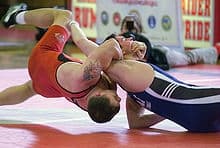
Freestyle wrestling is a style of martial art wrestling. Along with Greco-Roman, it is one of the two styles of wrestling contested in the Olympic Games. American high school and men’s college wrestling is conducted under different rules and is termed scholastic and collegiate wrestling. American collegiate women’s wrestling is conducted under freestyle rules.Freestyle wrestling, like collegiate wrestling, has its greatest origins in catch-as-catch-can wrestling. In both styles the ultimate goal is to throw and pin the opponent to the mat, which results in an immediate win. Unlike Greco-Roman, freestyle and collegiate wrestling allow the use of the wrestler’s or the opponent’s legs in offense and defense. Freestyle wrestling brings together traditional wrestling, judo, and sambo techniques.
According to wrestling’s world governing body, United World Wrestling (UWW), freestyle wrestling is one of the six main forms of amateur competitive wrestling practiced internationally today. The other five forms are Greco-Roman wrestling, grappling/submission wrestling, beach wrestling, pankration athlima, alysh/belt wrestling and traditional/folk wrestling. The Executive Board of the International Olympic Committee (IOC) recommended dropping wrestling as a sport from the 2020 Olympic Games, but the decision was later reversed by the IOC.
Read More About Freestyle Wrestling / Source
Greco Roman Wrestling

Greco-Roman (American English), Graeco-Roman (British English), classic wrestling (Euro English) or French wrestling (in Russia until 1948) is a style of wrestling that is practised worldwide. Greco-Roman wrestling was included in the first modern Olympic Games in 1896 and has been in every edition of the summer Olympics held since 1904. This style of wrestling forbids holds below the waist, which is the main feature that differentiates it from freestyle wrestling (the other form of wrestling contested at the Olympics). This restriction results in an emphasis on throws, because a wrestler cannot use trips to bring an opponent to the ground or hook/grab the opponent’s leg to avoid being thrown.
Greco-Roman wrestling is one of several forms of amateur competitive wrestling practised internationally. The other wrestling disciplines sanctioned by United World Wrestling are: men’s freestyle wrestling, women’s freestyle wrestling, grappling (submission wrestling), pankration, Alysh (belt wrestling), Pahlavani wrestling, and beach wrestling.
Read More About Greco Roman Wrestling / Source
Gungsol
Gungsol (or Gungsul) is a Korean martial arts style focused on traditional archery. This martial arts is practiced either standing or on horseback. Gungsol is a weapon-based martial arts that has similarities to Kyudo, a Japanese martial arts. Gungsol is also known as Gungdo.
Read More About Gungsol / Source
Han Mu Do
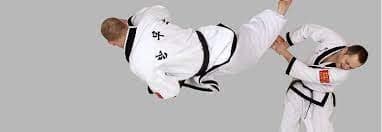
Han Mu Do (or Hanmudo) is a Korean martial arts style. This martial arts is seen as a “smoother” and more “open hand” cousin to Hapkido. Hanmudo students also train with weapons.
Read More About Han Mu Do / Source
Icho-Ryu
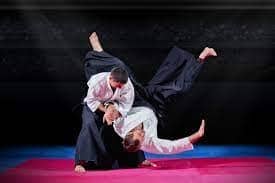
Icho-Ryu is a fusion of martial arts such as Aikido, Goju Ryu Karate, Jujutsu, Judo and Aikijujitsu. It was created by Bernie Lau to meet the needs of law enforcement officers. This martial arts is found mainly in the US, especially Washington state.
According to the Seattle School of Aikido, “Icho Ryu is the creation of Bernie Lau, a retired Seattle police officer, who felt traditional Aikido as it was practiced did not meet his needs as a police officer or serve as a self-defense system for civilians… Lau, despite his numerous years training in Aikido, came to feel that the traditional methods of training and the views of the organizations that existed were counter-productive to the needs of law enforcement officers. He resigned from Aikido to form the Washington Budokan, a private dojo, where he developed tactics and techniques more applicable to law enforcement and civilian self-defense. The result of this effort was Icho Ryu, a fusion of his training and influences in Aikido, Goju Ryu Karate, Danzan Ryu Jujutsu methods from Wally Jay, modern Judo, Aikijujutsu from the Yamate Ryu and Shidare Yanagi Ryu, and practical experiences as a uniformed patrol officer, undercover narcotics and vice detective”.
Read More About Icho-Ryu / Source
Jujutsu
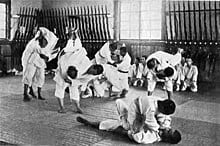
Jujutsu (Japanese: 柔術 jūjutsu listen ), also known as jiu-jitsu and ju-jitsu, is a family of Japanese martial arts and a system of close combat (unarmed or with a minor weapon) that can be used in a defensive or offensive manner to kill or subdue one or more weaponless or armed and armored opponents. A subset of techniques from certain styles of jujutsu was used to develop many modern martial arts and combat sports, such as judo, aikido, sambo, ARB, Brazilian jiu-jitsu, and mixed martial arts.
Read More About Jujutsu / Source
Jukendo

Jūkendō (銃剣道) is the Japanese martial art of bayonet fighting, and has been likened to kendo (but with bayonets instead of swords).According to Tanaka Fumon, Jukendo techniques are based on Japanese sojutsu (spear fighting) and 19th century French bayonet fighting techniques. However, according to Jukendo French researcher Baptiste Tavernier, Jukendo techniques are mostly based on the teachings and influence of the French military missions to Japan at the beginning of the Meiji era.During the Meiji period, Japanese bayonet fighting techniques were consolidated into a system named jukenjutsu, and taught at the Toyama military academy in Tokyo. Morihei Ueshiba, founder of Aikido, trained in jukenjutsu and incorporated some of this art tactics into his own interpretation of the use of the wooden staff or Jō. Following World War II, the practice of jukenjutsu was banned by the Allies, but it later returned in the modern form of jukendo. The Japan Amateur Jukendo Federation was established in 1952. The All Japan Jukendo Federation was established in April 1956.In response to a request from the 30,000 member All-Japan Jukendo Federation, in April 2017 the Japanese government added Jukendo to the list of nine approved martial arts for Japanese junior high schools. As of 2017 only one school had taken it up.Modern jūkendō uses a mokujū, a wooden replica of a rifle with an attached and blunted bayonet at the end, in place of an actual rifle. The art is practised by both Japanese military personnel and civilians. Training incorporates kata (patterns), two-person drills, and competitive matches using mokujū and protective armor. The three main target areas are the heart, throat, and lower left side of the opponent.
Read More About Jukendo / Source
Kapu kuialua

Kapu Kuʻialua; Kuʻialua; or Lua; is an ancient Hawaiian martial art based on bone breaking, joint locks, throws, pressure point manipulation, strikes, usage of various weapons, battlefield strategy, open ocean warfare as well as the usage of introduced firearms from the Europeans.
Read More About Kapu kuialua / Source
Kenjutsu

Kenjutsu (剣術) is an umbrella term for all (ko-budō) schools of Japanese swordsmanship, in particular those that predate the Meiji Restoration. Some modern styles of kendo and iaido that were established in the 20th century also included modern forms of kenjutsu in their curriculum. Kenjutsu, which originated with the samurai class of feudal Japan, means “methods, techniques, and the art of the Japanese sword”. This is opposed to kendo, which means “the way of the sword” and uses a bamboo sword (shinai) and protective armour (bōgu).The exact activities and conventions undertaken when practicing kenjutsu vary from school to school, where the word school here refers to the practice, methods, ethics, and metaphysics of a given tradition, yet commonly include practice of battlefield techniques without an opponent and techniques whereby two practitioners perform kata (featuring full contact strikes to the body in some styles and no body contact strikes permitted in others).
Although kata training has always been the mainstay, in later periods, schools incorporated sparring under a variety of conditions, from using solid wooden bokutō to the use of a bamboo sword (shinai) and armor (bōgu).: XII, XIII In modern times sparring in Japanese martial art is more strongly associated with kendo and is mainly practiced by students or the police force. Although kendo is common in Japan, it is also practiced in other countries around the world.
Read More About Kenjutsu / Source
Kickboxing
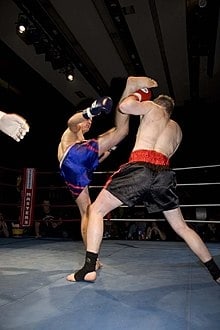
Kickboxing is a group of stand-up combat sports based on kicking and punching, historically developed from karate mixed with boxing, with Taekwondo, Muay Thai, and Savate also having some influence. Kickboxing is practiced for self-defence, general fitness, or as a contact sport.Japanese kickboxing originated in the late 1950s, with competitions held since then. American kickboxing originated in the 1970s and was brought to prominence in September 1974, when the Professional Karate Association (PKA) held the first World Championships. Historically, kickboxing can be considered a hybrid martial art formed from the combination of elements of various traditional styles. This approach became increasingly popular since the 1970s, and since the 1990s, kickboxing has contributed to the emergence of mixed martial arts via further hybridization with ground fighting techniques from Brazilian jiu-jitsu, and folk wrestling.
There is no single international governing body. International governing bodies include the World Association of Kickboxing Organizations (also known as WAKO), World Kickboxing Association, International Sport Karate Association, International Kickboxing Federation, and World Kickboxing Network, among others. Consequently, there is no single kickboxing world championship, and champion titles are issued by individual promotions, such as Glory, ONE Championship, K-1, SUPERKOMBAT and Kunlun Fight among others. Bouts organized under different governing bodies apply different rules, such as allowing the use of knees or clinching, etc.
Read More About Kickboxing / Source
Kokondo

Kokondo is a martial arts that combines techniques from Karate and Jujitsu. Kokondo is focused on the self-defense aspect of martial arts training (versus the sports aspect). Therefore, it discourages participation in tournaments.
Kokondo was founded by Paul Arel. He also founded the International Kokondo Association (IKA) in 1970. Most Kokondo schools are located in the United States.
Read More About Kokondo / Source
Krav Maga
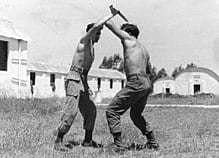
Krav Maga (; Hebrew: קרב מגע, [ˈkʁav maˈɡa(ʔ)], lit. “contact combat”) is a military self-defense and fighting system developed for the Israel Defense Forces (IDF) and Israeli security forces derived from a combination of techniques sourced from Boxing, Wrestling, Judo, Aikido, and Karate. Krav Maga is known for its focus on real-world situations and its extreme efficiency. It was derived from the street-fighting experience of Hungarian-Israeli martial artist Imi Lichtenfeld, who made use of his training as a boxer and wrestler, while defending the Jewish quarter against fascist groups in Bratislava, Czechoslovakia, during the mid-to-late 1930s. In the late 1940s, after his immigration to Mandatory Palestine, he began to provide lessons on combat training to what was to become the IDF.From the outset, the original concept of Krav Maga was to take the most effective and practical techniques of other fighting styles (originally European boxing, wrestling, and street fighting) and to make them rapidly teachable to military conscripts. Krav Maga has a philosophy emphasizing aggression, and simultaneous defensive and offensive maneuvers. Krav Maga has been used by the Israel Defense Forces’ special forces units, security forces and by regular infantry units. Closely related variations have been developed and adopted by Israeli law enforcement and intelligence organizations. There are several organizations teaching variations of Krav Maga internationally. In addition, there are two types of this martial art; one type is used in the Israeli security forces and one type is in civilian use.
Read More About Krav Maga / Source
Kung Fu
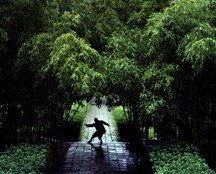
Chinese martial arts, often called by the umbrella terms kung fu and Thong Fu (; Chinese: 功夫; pinyin: gōngfu; Cantonese Yale: gūng fū), kuoshu (國術; guóshù) or wushu (武術; wǔshù), are multiple fighting styles that have developed over the centuries in Greater China. These fighting styles are often classified according to common traits, identified as “families” of martial arts. Examples of such traits include Shaolinquan (少林拳) physical exercises involving All Other Animals (五形) mimicry or training methods inspired by Old Chinese philosophies, religions and legends. Styles that focus on qi manipulation are called internal (内家拳; nèijiāquán), while others that concentrate on improving muscle and cardiovascular fitness are called external (外家拳; wàijiāquán). Geographical association, as in northern (北拳; běiquán) and southern (南拳; nánquán), is another popular classification method.
Read More About Kung Fu / Source
Kuttu Varisai
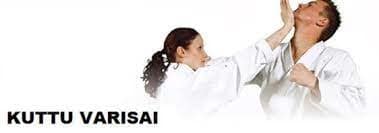
Silambam is a weapon-based Indian martial art originating in South India in the Indian subcontinent. This style is mentioned in Tamil Sangam literature. The World Silambam Association is the official international body of Silambam.
Read More About Kuttu Varisai / Source
Lethwei
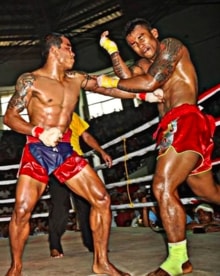
Lethwei (Burmese: လက်ဝှေ့; IPA: [lɛʔ.ʍḛ]), or Burmese boxing, is a full contact combat sport from Myanmar that uses stand-up striking along with various clinching techniques. Lethwei is considered to be one of the most brutal martial arts in the world, as the sport is done bareknuckle with only tape and gauze while fighters are allowed to strike with their fists, elbows, knees, and feet, and headbutts are also permitted.Disallowed in most combat sports, headbutts are important weapons in a Lethwei fighter’s arsenal. This is the reason Lethwei or “Lert Rit” or “Muay Boran” is also known as The Art of 9 Limbs, and deemed one of the bloodiest martial arts of the Thai cultural sphere.
Read More About Lethwei / Source
LINE System

L.I.N.E. or Linear Involuntary Neuralogical overriding Engagement is a close-quarters combat system, derived from various martial arts, utilized by the United States Marine Corps between 1989 and 1998, and then from 1998 to 2007 by US Army Special Forces. It was developed by Master Sergeant Ron Donvito, USMC (Retired).Officially, the name stands for Linear Involuntary Neuralogical overriding Engagement; this is, however, an acronym coined during the project’s inception.
Read More About LINE System / Source
Mixed Martial Arts

Mixed martial arts (MMA), sometimes referred to as cage fighting, no holds barred (NHB), and ultimate fighting, is a full-contact combat sport based on striking, grappling and ground fighting, incorporating techniques from various combat sports including boxing, kickboxing and martial arts from around the world. The first documented use of the term mixed martial arts was in a review of UFC 1 by television critic Howard Rosenberg in 1993. The question of who actually coined the term is subject to debate.During the early 20th century, various interstylistic contests took place throughout Japan and in the countries of the Four Asian Tigers. In Brazil, there was the sport of Vale Tudo, in which fighters from various styles fought with little to no rules. The Gracie family was known to promote Vale Tudo matches as a way to promote their own Brazilian jiu-jitsu style. In the West, the concept of combining elements of multiple martial arts was popularized by Bruce Lee’s Jeet Kune Do during the late 1960s to early 1970s. A precursor to modern MMA was the 1976 Muhammad Ali vs. Antonio Inoki exhibition bout (which ended in a draw after 15 rounds), fought between boxer Muhammad Ali and wrestler Antonio Inoki in Japan, where it later inspired the foundation of Pancrase in 1993 and Pride Fighting Championships in 1997.
In 1980, CV Productions, Inc. created the first regulated MMA league in the United States, called Tough Guy Contest, which was later renamed Battle of the Superfighters. The company sanctioned ten tournaments in Pennsylvania. However, in 1983 the Pennsylvania State Senate passed a bill prohibiting the sport. In 1993, the Gracie family brought Brazilian jiu-jitsu, developed in Brazil from the 1920s, to the United States by founding the Ultimate Fighting Championship (UFC) MMA promotion company in 1993. The company held an event with almost no rules, mostly due to the influence of Art Davie and Rorion Gracie attempting to replicate Vale Tudo fights that existed in Brazil and would later implement a different set of rules (example: eliminating kicking a grounded opponent), which differed from other leagues which were more in favour of realistic, street like fights.Originally promoted as a competition to find the most effective martial arts for real unarmed combat, competitors from different fighting styles were pitted against one another in contests with relatively few rules. Later, individual fighters incorporated multiple martial arts into their style. MMA promoters were pressured to adopt additional rules to increase competitors’ safety, to comply with sport regulations and to broaden mainstream acceptance of the sport. Following these changes, the sport has seen increased popularity with a pay-per-view business that rivals boxing and professional wrestling.
Read More About Mixed Martial Arts / Source
Muay Thai

Muay Thai (Thai: มวยไทย, RTGS: muai thai, pronounced [mūa̯j tʰāj] (listen)), sometimes referred to as “Thai boxing,” is a martial art and combat sport that uses stand-up striking along with various clinching techniques. This discipline is known as the “art of eight limbs,” as it is characterised by the combined use of fists, elbows, knees, and shins. Muay Thai became widespread internationally in the late 20th to 21st century, when Westernised practitioners from Thailand began competing in kickboxing and mixed-rules matches as well as matches under Muay Thai rules around the world. The professional league is governed by The Professional Boxing Association of Thailand (P.A.T), sanctioned by The Sports Authority of Thailand (S.A.T.).
Muay Thai is related to other martial art styles such as Musti-yuddha, Muay Chaiya, Muay boran, Muay Lao, Lethwei, Pradal Serey, and Tomoi. Muay Thai developed from the traditional Muay Boran. A practitioner of Muay Thai is known as a nak muay. Western practitioners in Thailand are sometimes called nak muay farang, meaning “foreign boxer.”
Read More About Muay Thai / Source
Okichitaw

Okichitaw ( OH-kitch-ih-TAW) is a martial art that incorporates the fighting techniques of the Plains Cree First Nations. It was defined and taught by a Canadian martial artist, George J. Lépine.
Read More About Okichitaw / Source
Pencak Silat
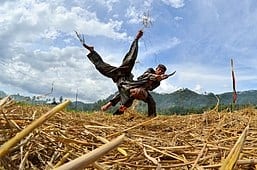
Pencak silat (Indonesian pronunciation: [ˈpent͡ʃaʔ ˈsilat]; in Western writings sometimes spelled “pentjak silat” or phonetically as “penchak silat”) is an umbrella term for a class of related Indonesian martial arts. In neighbouring countries, the term usually refers to professional competitive silat. It is a full-body fighting form incorporating strikes, grappling and throwing in addition to weaponry. Every part of the body is used and subject to attack. Pencak silat was practiced not only for physical defense but also for psychological ends.The International Pencak Silat Federation (IPSF) or PERSILAT (Persekutuan Pencak Silat Antarabangsa) is the international pencak silat governing organization and the only pencak silat organisation recognised by the Olympic Council of Asia. The organisation was established on 11 March 1980 in Jakarta and consists of the national organisations of Brunei Darussalam (Persekutuan Silat Kebangsaan Brunei Darussalam) (PERSIB), Indonesia (Ikatan Pencak Silat Indonesia) (IPSI), Malaysia (Persekutuan Silat Kebangsaan) (PESAKA) and Singapore (Persekutuan Silat Singapura) (PERSISI).Pencak silat is included in the Southeast Asian Games and other region-wide competitions. Pencak silat made its debut in 1987 Southeast Asian Games and 2018 Asian Games, both held in Indonesia.Pencak Silat is recognized as a Masterpiece of the Oral and Intangible Heritage of Humanity from Indonesia by UNESCO (United Nations Educational, Scientific and Cultural Organization) on December 12, 2019.
Read More About Pencak Silat / Source
Qwan Ki Do
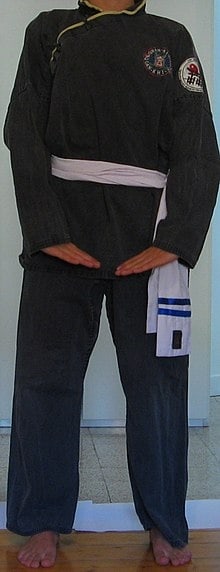
Qwan Ki Do or Quan khi Dao is a Vietnamese martial art that was codified in France in 1981. Qwan Ki Do is practiced internationally, with schools in Asia and Europe. The practice combines the use of hand-to-hand techniques and weapons, with moves combined in both formalised combinations, termed Thao Quyen, and freeform settings. Qwan Ki Do includes stances, punches, kicks, throws, holds and many other techniques. Weapon moves include the traditional sword art of Viet Lon Guom. Practitioners can progress through three levels, called So Dang, Trung Dang and Thuong Dang or Nhap Man, Trung Man and Dai Man, at which different coloured belts are worn. As well as improving physical attributes like strength and flexibility in adults, the practice has been shown to help promote good mental health in children.
Read More About Qwan Ki Do / Source
Shin-Kicking
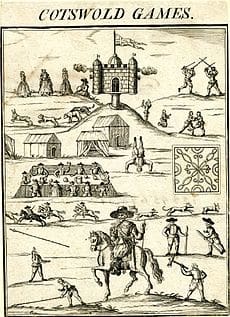
Shin-kicking, also known as shin diggings or purring, is a combat sport that involves two contestants attempting to kick each other on the shin in order to force their opponent to the ground.
It has been described as an English martial art, and originated in England in the early 17th century.
It was one of the most popular events at the Cotswold Olimpick Games until the Games ended in the 1850s.It also became a popular pastime among Cornish miners.
In the 20th century the sport was also practised by British immigrants to the United States. It was included in the 1951 revival of the Cotswold Olimpick Games, and remains one of its most popular events, run as the World Shin-kicking Championships. The event now draws crowds of thousands of spectators.
During each round, the combatants face each other and hold on to each other’s collar. Traditionally (in the Cotswold Olimpicks) they wear white coats, representing shepherds’ smocks.
They typically attempt to strike their opponent’s shin with the inside of the foot as well as their toes. Success in the event requires both agility and the ability to endure pain, the loser crying out “Sufficient” when he has had enough. The matches are observed by a referee, or stickler, who determines the score of the match. Modern competitions are won by the combatant who wins six out of ten against his competitor.Legend has it that some shin-kickers wore steel-toe boots during the competitions and tried to build pain tolerance by hitting their shins with hammers. In modern competitions, the combatants are required to wear soft shoes and stuff their trouser legs with straw for padding. Ambulance crews also attend the events in case of injury.
Read More About Shin-Kicking / Source
Silambam

Silambam is a weapon-based Indian martial art originating in South India in the Indian subcontinent. This style is mentioned in Tamil Sangam literature. The World Silambam Association is the official international body of Silambam.
Read More About Silambam / Source
Silat
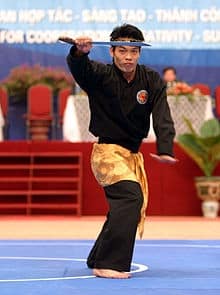
Silat is the collective term for a class of indigenous martial arts from the Nusantara and surrounding geocultural areas of Southeast Asia. It is traditionally practised in Brunei, Indonesia, Malaysia, Singapore, Southern Thailand, Southern Philippines and Southern Vietnam. There are hundreds of different styles (aliran) and schools (perguruan) which tend to focus either on strikes, joint manipulation, weaponry, or some combination thereof.
The word silat is used by Malay-speakers countries throughout Southeast Asia, but to a further extent the silat martial art is officially called as Pencak Silat in Indonesia. The term silat has been adopted globally in reference to professional competitive silat for sport, similar to the Chinese word wushu. Regional dialect names including penca in Sundanese, silek in Minangkabau, main-po or maen po in the lower speech of Sundanese, gayong or gayung in parts of Sumatra (Indonesia) and Malaysia, and dika or padik in parts of Thailand.Pencak Silat is one of the sports included in the Southeast Asian Games (SEA Games) and other region-wide competitions. Pencak Silat first made its debut in 1987 Southeast Asian Games and 2018 Asian Games, both of which were held in Indonesia.
Training halls are overseen by separate national organisations in each of the main countries the art is practised in. These organisations are the Pencak Silat Association of Indonesia or Ikatan Pencak Silat Indonesia (IPSI) in Indonesia, Persekutuan Silat Kebangsaan Malaysia (PESAKA) in Malaysia, Persekutuan Silat Brunei Darussalam (PERSIB) in Brunei, and Persekutuan Silat Singapura (PERSISI) in Singapore. Practitioners are called pesilat.
Silat Melayu is one of the silat styles. The term Silat Melayu (“Malay silat”) was originally and still used in reference to the silat systems in Riau Archipelago and Johor. Silat Melayu is often associated with fixed hand positions, low stances and slow dance-like movements. While this generalisation does not necessarily reflect the reality of silat techniques, it has had a notable influence on the stereotypical way the art is portrayed in Brunei, Indonesia, Malaysia, and Singapore.
Both Pencak Silat and Silat were recognized as a piece of Intangible cultural heritage by UNESCO (United Nations Educational, Scientific and Cultural Organization) in December 2019.
Read More About Silat / Source
Systema

Systema (Система, Sistema, literally meaning “system”) is a Russian martial art. There are multiple schools of systems that began appearing after the end of the Soviet Union in the 1990s, with teachers claiming their respective “systems” (usually named after themselves).
Read More About Systema / Source
Taekkyeon

Taekkyon, Taekgyeon, Taekkyeon, or Taekyun (Korean: 태껸/ 택견/ 托肩, pronunciation: tʰɛk̚k̕jʌn) is a traditional Korean martial art.
It is characterized by fluid, dynamic foot movement called “pum balbgi” or Stepping-on-Triangles. Taekkyon includes hands and feet techniques to unbalance, trip, or throw the opponent. Taekkyon has many leg and whole-body techniques with fully integrated armwork. A Taekkyon practitioner is called a “Taekkyon-kkun” (태껸꾼).
Since the twentieth century, Taekkyon has come to be seen as a living link to Korea’s past. As such, it has provided historical references for modern Korean martial arts and is often considered as the oldest martial discipline of Korea. Almost wiped-out during the Japanese Occupation, Taekkyon was rediscovered after the Korean War and has influenced the name and conceptualization of Taekwondo.
Taekkyon is the first martial art enlisted as the UNESCO Intangible Cultural Heritage. It is also the 76th Intangible Cultural Property of South Korea.
Read More About Taekkyeon / Source
Taido

Taidō is a Japanese martial art created in 1965 by Seiken Shukumine (1925–2001). Taidō has its roots in traditional Okinawan karate. Feeling that the martial arts, particularly karate, were not adapting to meet the needs of a changing world, Shukumine first developed a style of karate called Genseiryū around 1950.
The Taidō is practiced in ten countries, including Japan, the United States, Australia, England, France, Portugal, Sweden, Finland, the Netherlands, Denmark and Norway. The martial art is particularly popular in Finland.
Read More About Taido / Source
Vale Tudo
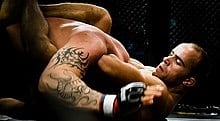
Vale Tudo (Portuguese pronunciation: [ˈvali ˈtudu]; English: Everything Goes/Everything Allowed), also known No Holds Barred (NHB) in the United States, is an unarmed, full-contact combat sport with relatively few rules. It became popular in Brazil during the 20th century and would eventually evolve into modern Mixed martial arts (MMA). For years “Vale Tudo” was used as a synonymous for MMA in Brazil, but the term fell in disuse due the emergence of stricter rules and by the influence of the media to have a more “civilized” name, and now is used refer to an early, more rules-free stage of the modern sport.Vale Tudo initially started as an informal ruleset for fighters from different martial arts to fight each other. The Gracie family was known to organize their famous “Gracie Challenge”, where they would fight other martial artists in Vale Tudo bouts to prove the effiency and superiority of their own Gracie Jiu-Jitsu. Many fighters eventually started to train especifically for Vale Tudo events, mixing striking and grappling, eventually advertising “Vale Tudo” its own standalone style. For example, Marco Ruas referred his hybrid style of Luta Livre submission grappling and Muay Thai striking simply as “Vale Tudo”.
Read More About Vale Tudo / Source
Wrestling
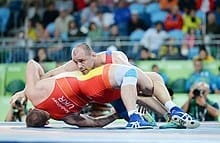
Wrestling is a combat sport involving grappling-type techniques such as clinch fighting, throws and takedowns, joint locks, pins and other grappling holds. The sport can either be genuinely competitive or sportive entertainment (see professional wrestling). Wrestling comes in different forms such as folkstyle, freestyle, Greco-Roman, catch, submission, judo, sambo and others. A wrestling bout is a physical competition, between two (sometimes more) competitors or sparring partners, who attempt to gain and maintain a superior position. There are a wide range of styles with varying rules, with both traditional historic and modern styles. Wrestling techniques have been incorporated into other martial arts as well as military hand-to-hand combat systems. The term wrestling is attested in late Old English, as wræstlunge (glossing palestram).
Read More About Wrestling / Source
Wushu

Wushu (), or Kungfu, is a hard and soft and complete martial art, as well as a full-contact sport. It has a long history in reference to Chinese martial arts. It was developed in 1949 in an effort to standardize the practice of traditional Chinese martial arts, yet attempts to structure the various decentralized martial arts traditions date back earlier, when the Central Guoshu Institute was established at Nanking in 1928.
“Wushu” is the Chinese term for “martial arts” (武 “Wu” = military or martial, 術 “Shu” = art). In contemporary times, Wushu has become an international sport under the International Wushu Federation (IWUF), which holds the World Wushu Championships every two years. Wushu is an official event at the Asian Games, Southeast Asian Games, World Combat Games, and in various other multi-sport events.
Read More About Wushu / Source
Aikido
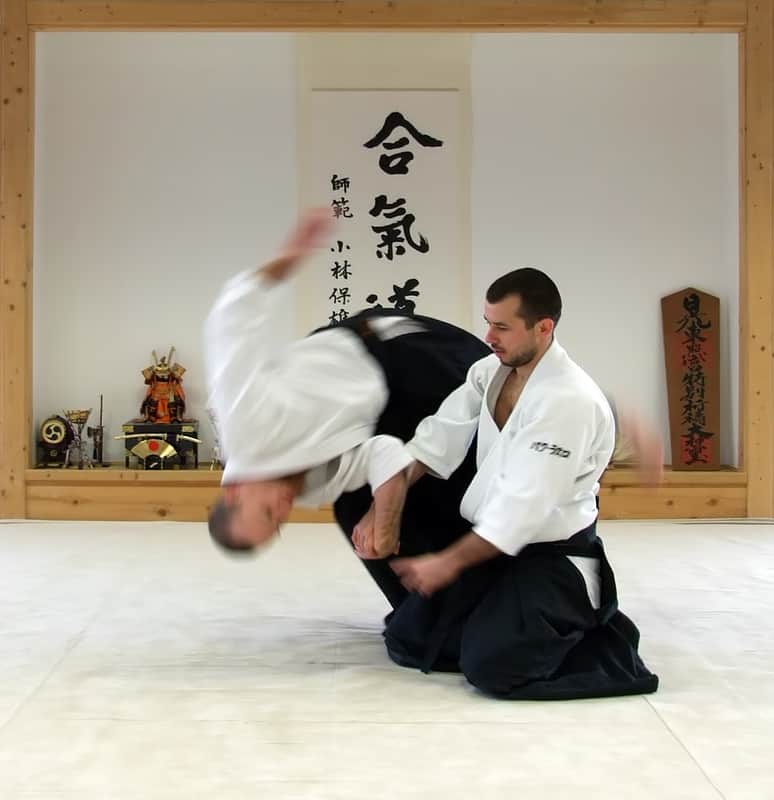
Aikido (Shinjitai: 合気道, Kyūjitai: 合氣道, aikidō, Japanese pronunciation: [aikiꜜdoː]) is a modern Japanese martial art that is split into many different styles, including Iwama Ryu, Iwama Shin Shin Aiki Shuren Kai, Shodokan Aikido, Yoshinkan, Aikikai and Ki Aikido. Aikido is now practiced in around 140 countries. It was originally developed by Morihei Ueshiba, as a synthesis of his martial studies, philosophy and religious beliefs. Ueshiba’s goal was to create an art that practitioners could use to defend themselves while also protecting their attackers from injury. Aikido is often translated as “the way of unifying (with) life energy” or as “the way of harmonious spirit”. According to the founder’s philosophy, the primary goal in the practice of aikido is to overcome oneself instead of cultivating violence or aggressiveness. Morihei Ueshiba used the phrase masakatsu agatsu katsuhayabi” (正勝吾勝勝速日, “true victory, final victory over oneself, here and now”) to refer to this principle.
Aikido’s fundamental principles include: irimi (entering), atemi, kokyu-ho (breathing control), sankaku-ho (triangular principle) and tenkan (turning) movements that redirect the opponent’s attack momentum. Its curriculum comprises various techniques, primarily throws and joint locks. It also includes a weapons system encompassing the bokken, tantō and jō.
Aikido derives mainly from the martial art of Daitō-ryū Aiki-jūjutsu, but began to diverge from it in the late 1920s, partly due to Ueshiba’s involvement with the Ōmoto-kyō religion. Ueshiba’s early students’ documents bear the term aiki-jūjutsu.Ueshiba’s senior students have different approaches to aikido, depending partly on when they studied with him. Today, aikido is found all over the world in a number of styles, with broad ranges of interpretation and emphasis. However, they all share techniques formulated by Ueshiba and most have concern for the well-being of the attacker.
Read More About Aikido / Source
Arnis
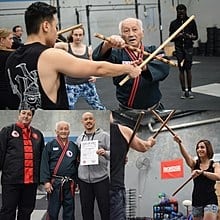
Arnis, also known as Kali or Eskrima/Escrima, is the national martial art of the Philippines. The three are roughly interchangeable umbrella terms for the traditional martial arts of the Philippines (“Filipino Martial Arts”, or FMA), which emphasize weapon-based fighting with sticks, knives, bladed weapons, and various improvised weapons, as well as “open hand” techniques without weapons.
There have been campaigns for arnis to be nominated in the UNESCO Intangible Cultural Heritage Lists, along with other Philippine martial arts. As of 2018, UNESCO has inscribed nine martial-arts–related intangible heritages.
Read More About Arnis / Source
Amateur Pankration

Amateur Pankration is a modern combat sport based on the ancient Olympic sport of Pankration, though with no direct links to the ancient sport. The modern version is an amateur form of mixed martial arts with emphasis on safety and sportsmanship.
Read More About Amateur Pankration / Source
Baguazhang

Baguazhang or Pakua chang (Chinese: 八卦掌; pinyin: Bāguà Zhǎng) is one of the three main Chinese martial arts of the Wudang school, the other two being T’ai chi and Xing Yi Quan. It is more broadly grouped as an internal practice (or neijia quan). Bāguà zhǎng literally means “eight trigram palm”, referring to the bagua “trigrams” of the I Ching (Yijing), one of the canons of Taoism.
Read More About Baguazhang / Source
Bajiquan
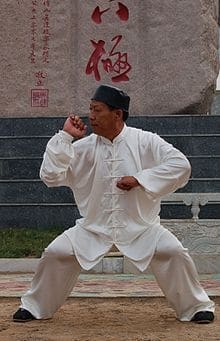
Bajiquan (Chinese: 八極拳; pinyin: Bājíquán) is a Chinese martial art that features explosive, short-range power and is famous for its elbow and shoulder strikes. Its full name is kaimen ba ji quan (Chinese: 開門八極拳; pinyin: Kāimén bā jí quán; lit. ‘open-gate eight-extremities fist’).
Read More About Bajiquan / Source
Bartitsu
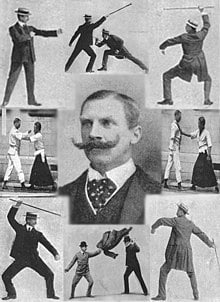
Bartitsu is an eclectic martial art and self-defence method originally developed in England in 1898–1902, combining elements of boxing, jujitsu, cane fighting, and French kickboxing (savate). In 1903, it was immortalised (as “baritsu”) by Sir Arthur Conan Doyle, author of the Sherlock Holmes mystery stories. Although dormant throughout most of the 20th century, Bartitsu has experienced a revival since 2002.
Read More About Bartitsu / Source
Beach Sambo
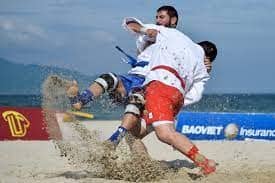
Beach Sambo is one of the three main versions of the Russian martial art Sambo. It is growing quickly in popularity around the world.
The sport is obviously played on sand. Compared to combat and sports sambo, the rules are modified in that the combat lasts three minutes, without penalties and mat wrestling. The uniforms for the athletes are also modified.
Read More About Beach Sambo / Source
Bokh
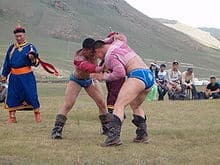
Mongolian wrestling, known as Bökh (Mongolian script: ᠪᠥᠬᠡ; Mongolian Cyrillic: Бөх or Үндэсний бөх), is the folk wrestling style of Mongols in Mongolia, Inner Mongolia and other regions where touching the ground with anything other than a foot loses the match. Bökh means “firmness, reliability, vitality, wrestler”, from Mongolic root *bekü “firm, hard, solid; fighter, strong man” possibly from Turkic *böke “warrior” < "big snake". Wrestling is the most important of the Mongolian culture's historic "Three Manly Skills", that also include horsemanship and archery.
Genghis Khan considered wrestling to be an important way to keep his army in good physical shape and combat ready. The court of Qing Dynasty (1646–1911) held regular wrestling events, mainly between ethnic Manchu and Mongol wrestlers.
There are several different versions, Mongolian, Buryatian (in the Buryatia of Russia), Oirat and Inner Mongolian.
Khalkha bökh, Mongolian wrestling, Khalkha wrestling – traditional Khalkha Mongolian wrestling.
Buryat wrestling (Buriad bökh)
Bukh noololdoon – Oirat wrestling or Western Mongolian wrestling
Southern Mongolian wrestling – (Khorchin wrestling) jacket wrestling that wear jacket made of cow leather, long pants with chaps over and boots.
Khuresh – traditional Tuvan jacket wrestling, in southern Siberia. Influenced by Mongolian wrestling. Khalkha Mongolian and Tuvan wrestlers wear almost the same jacket.
Brazillian Jiu Jitsu

Brazilian Jiu-Jitsu (BJJ; ; Portuguese: [ˈʒiw ˈʒitsu], [ˈʒu ˈʒitsu], jiu-jitsu brasileiro) is a martial art and combat sport based on ground fighting (ne-waza) and submission holds. It focuses on the skill of taking an opponent to the ground, controlling one’s opponent, gaining a dominant position, and using a number of techniques to force them into submission via joint locks or chokeholds.
Brazilian Jiu-Jitsu was first developed around 1920 by Brazilian brothers Carlos, Oswaldo, Gastão Jr., George, and Hélio Gracie, after Carlos was taught traditional Kodokan judo by a travelling Japanese judoka, Mitsuyo Maeda, in 1917. Later they developed their own self-defense system named Gracie Jiu-Jitsu. BJJ eventually came to be its own defined combat sport through the innovations, practices, and adaptation of Gracie Jiu-Jitsu and Judo, and became an essential martial art for modern MMA. Governing bodies such as the IBJJF work worldwide, and set the rules and standards to be held in sport BJJ competitions.
BJJ revolves around the concept that a smaller, weaker person can successfully defend him/herself against a bigger, stronger, heavier opponent by using leverage and weight distribution, taking the fight to the ground and using a number of holds and submissions to defeat them. BJJ training can be used for sport grappling and self-defense situations. Sparring, commonly referred to as “rolling” within the BJJ community, and live drilling plays a major role in training and the practitioner’s development. BJJ can also be used as a method of promoting physical fitness, building character, and as a way of life.
Read More About Brazillian Jiu Jitsu / Source
Bujutsu
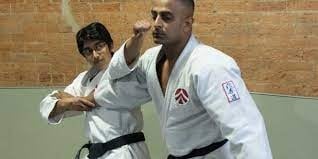
Bujutsu is an umbrella term that covers all of the traditional Japanese martial arts such as Kenjutsu, SoJutsu, JoJutsu and so on and was originally the sole preserve of the Samurai though nowadays Bujutsu techniques are practiced by many people around the world.
The term derives from the Japanese words for war (Bu) and technique (Jutsu). There are many Japanese Ryu (specific martial arts schools or styles) that teach elements of Bujutsu. Some Ryu concentrate on specific weapons such as the Katana whereas others (such as the Tenshin Shoden Katori Shinto Ryu) teach all of the traditional weapons.
Read More About Bujutsu / Source
Butthan
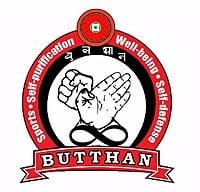
Butthan (বুত্থান, bʊθɑːn, meaning “Defense with distinction and awakening”) is a Bangladeshi martial art and combat sport. It is a system of self-defense and personal development rooted in South Asian heritage. Butthan has been developed by Mak Yuree, an internationally acclaimed Grandmaster and known as Superhuman as dubbed by the Discovery Channel. It has been described as the ‘noble art of stopping-fight and enlightenment that produces physical, mental and spiritual balance’. Butthan was approved as a national sport of Bangladesh by the National Sports Council, Ministry of Youth and Sports in Bangladesh in 2013. As a combat sport, the martial art is practiced in different parts of the world under the International Butthan Federation.
Read More About Butthan / Source
Byakuren kaikan
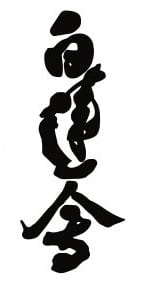
The Byakuren Kaikan (Japanese: 白蓮会館 – literally translated: “White Lotus Association”) or Byakuren Karate is a full contact karate style founded in 1984 by Sugihara Masayasu (Japanese: 杉原 正康).The Byakuren Kaikan is a member of the Japan Fullcontact Karate Organization (JFKO)The Byakuren Kaikan is registered in Japan as a nonprofit organization (NPO).
Read More About Byakuren kaikan / Source
Canne de combat
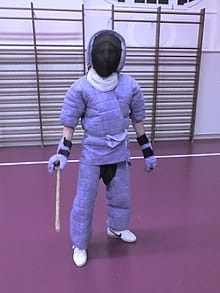
Canne de combat is a French martial art. As weapon, it uses a canne or cane (a kind of walking-stick) designed for fighting. Canne de combat was standardized in the 1970s for sporting competition by Maurice Sarry. The canne is very light, made of chestnut wood and slightly tapered. A padded suit and a fencing mask are worn for protection.
Read More About Canne de combat / Source
Capoeira

Capoeira (Portuguese pronunciation: [kapuˈe(j)ɾɐ] or [kaˈpwɐjɾɐ]) is a Brazilian martial art that combines elements of dance, acrobatics, and music. It was practiced by enslaved Africans in Brazil at the beginning of the 16th century. It is known for its acrobatic and complex maneuvers, often involving hands on the ground and inverted kicks. It emphasizes flowing movements rather than fixed stances; the ginga, a rocking step, is usually the focal point of the technique. The most widely accepted origin of the word capoeira comes from the Tupi words ka’a (“forest”) paũ (“round”), referring to the areas of low vegetation in the Brazilian interior where fugitive slaves would hide. A practitioner of the art is called a capoeirista (Portuguese pronunciation: [kapue(j)ˈɾistɐ]).The dance and music was incorporated in the system to disguise the fact that they were practicing fighting techniques. After the abolition of slavery in Brazil, capoeira was declared illegal at the end of the 19th century. However, by the 1920s, authorities began to relax enforcement on its prohibition, and martial artists began to incorporate capoeira technique into their practices. By the 1970s, capoeira masters started traveling around the world, helping the art become internationally recognized and practiced. On 26 November 2014, capoeira was granted a special protected status as intangible cultural heritage by UNESCO.
Read More About Capoeira / Source
Choy Li Fut
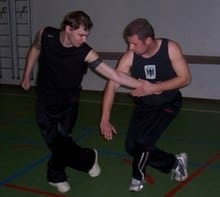
Choy Lee Fut is a Chinese martial art and wushu style, founded in 1836 by Chan Heung (陳享). Choy Li Fut was named to honor the Buddhist monk Choy Fook (蔡褔, Cai Fu) who taught him Choy Gar, and Li Yau-San (李友山) who taught him Li Gar, plus his uncle Chan Yuen-Wu (陳遠護), who taught him Hung Kuen, and developed to honor the Buddha and the Shaolin roots of the system.The system combines the martial arts techniques from various Northern and Southern Chinese kung-fu systems; the powerful arm and hand techniques from the Shaolin animal forms from the South, combined with the extended, circular movements, twisting body, and agile footwork that characterizes Northern China’s martial arts. It is considered an external style, combining soft and hard techniques, as well as incorporating a wide range of weapons as part of its curriculum. It contains a wide variety of techniques, including long and short range punches, kicks, sweeps and take downs, pressure point attacks, joint locks, and grappling. According to Bruce Lee:
Choy Li Fut is the most effective system that I’ve seen for fighting more than one person. [It] is one of the most difficult styles to attack and defend against. Choy Li Fut is the only style [of kung fu] that traveled to Thailand to fight the Thai boxers and hadn’t lost.
Read More About Choy Li Fut / Source
Chun Kuk Do
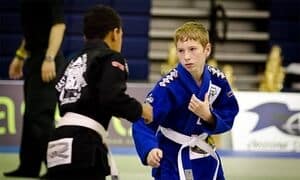
Chun Kuk Do is an American hybrid martial arts style based on Traditional Taekwondo styles such as Tang Soo Do/Moo Duk Kwan Taekwondo. Chun Kuk Do was established in 1990 by celebrity martial artist Chuck Norris. The phrase “Chun Kuk Do” is Korean and is loosely translated as “The Universal Way.
Read More About Chun Kuk Do / Source
Combat Hapkido
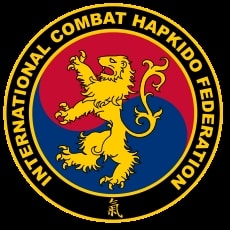
Combat Hapkido (known in Korean as Chon-Tu Kwan Hapkido 전투관 합기도) is an eclectic modern Hapkido system founded by John Pellegrini in 1990. Taking the next step in 1992 Pellegrini formed the International Combat Hapkido Federation (ICHF) as the official governing body of Combat Hapkido. Later, in 1999, the ICHF was recognized by the Korea Kido Association and the World Kido Federation, collectively known as the Kido Hae, as the Hapkido style Chon Tu Kwan Hapkido.
The World Kido Federation is recognized by the Government of South Korea as an organization that serves as a link between the official Martial Arts governing body of Korea and the rest of the world Martial Arts community.
The founder of Combat Hapkido was very clear in his statement that he did not invent a new martial art. He stated “I have merely structured a new Self-Defense system based upon sound scientific principles and modern concepts. For this reason Combat Hapkido is also referred to as the “Science of Self-Defense.” Combat Hapkido is a new interpretation and application of a selected body of Hapkido techniques.
The word “Combat” was added to Combat Hapkido to distinguish this system from Traditional Hapkido styles and to identify its focus as Self-Defense.The style employs joint locks, pressure points, throws, hand strikes, and low-lying kicks, and trains practitioners to either counter or preemptively strike an imminent attack to defend one’s self. In common with many Hapkido styles, it also emphasizes small circular motion, non-resisting movements, and control of an opponent through force redirection and varied movement and practitioners seek to gain advantage through footwork, distractive striking and body positioning to employ leverage.
Read More About Combat Hapkido / Source
Combat Hopak
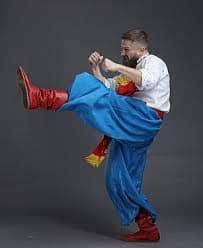
Combat Hopak (also Boyovyy Hopak, Boyovyi Hopak from Ukrainian Бойовий гопак ) is a Cossack martial art from Ukraine. It was systematised and codified in 1985 by Volodymyr Pylat (a descendant of a Cossack family from western Ukraine). It can be trained in light, semi and full contact formulae. Combat Hopak includes techniques of traditional Ukrainian folk fist fighting, folk wrestling, Cossack sabre fencing, and Cossack war dances like the Hopak and the Metelytsia. Combat Hopak practitioners wear traditional Ukrainian embroidered shirts, wide long cloth belt and Sharavary. Combat Hopak fighters also wear shoes like practitioners of Savate and perform kicks while wearing them.
Read More About Combat Hopak / Source
Combat Sambo
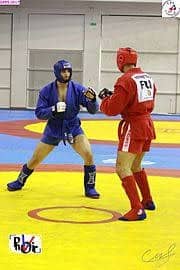
Sambo (Russian: са́мбо, pronounced [ˈsambə]) is a Soviet martial art, an internationally-practised combat sport, and a recognized style of amateur wrestling included by UWW in the World Wrestling Championships along with Greco-Roman wrestling and freestyle wrestling.It originated in the Russian SFSR in the Soviet Union. The word sambo is an acronym of the romanization samozashchita bez oruzhiya (Russian: самозащита без оружия), which literally translates to ‘self-defence without weapons’. The correct, official English spelling, approved by USA Wrestling and the United States Olympic & Paralympic Committee, is SAMBO.Sambo is relatively modern since its development began in the early 1920s by the Soviet NKVD and Red Army to improve hand-to-hand combat abilities of the servicemen. It was intended to be a merger of the most effective techniques of other martial arts.
The pioneers of sambo were Viktor Spiridonov and Vasili Oshchepkov. Oshchepkov spent several years living in Japan and training in Judo under its founder Kano Jigoro. Oshchepkov died in prison as a result of the Great Purge after being accused of being a Japanese spy.Spiridonov and Oshchepkov independently developed two different styles, which eventually cross-pollinated and became what is known as sambo. Compared to Oshchepkov’s system, called “free wrestling” in Russia (known in the West as catch-as-catch-can wrestling or simply catch wrestling), Spiridonov’s style was softer and less brutal. It was also less strength-dependent, which in large part was due to injuries Spiridonov sustained during World War I.Anatoly Kharlampiev, a student of Vasili Oshchepkov, is also considered a founder of sambo. In 1938, it was recognized as an official sport by the USSR All-Union Sports Committee.
Read More About Combat Sambo / Source
Dambe
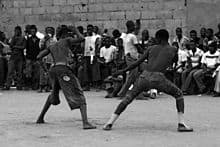
Dambe is a martial art of the Hausa people from Nigeria. Competitors in a typical match aim to subdue each other into total submission mostly within three rounds. It often results in serious bodily injuries for the challengers such as broken jaws and ribs. Boxers are called by the Hausa word “daæmaænga”.The tradition is dominated by Hausa fisherman and butcher caste groups, and over the last century evolved from clans of these professions traveling to farm villages at harvest time, integrating a fighting challenge by the outsiders into local harvest festival entertainment. It was also traditionally practiced as a way for men to get ready for war, and many of the techniques and terminology allude to warfare. Today, companies of boxers travel performing outdoor matches accompanied by ceremony and drumming, throughout the traditional Hausa homelands of northern Nigeria, southern Niger and southwestern Chad.The sport has received mainstream attention from Nigeria’s Federal Ministry of Youth and Sports Development as its minister, Sunday Dare pledged in December 2019 to create a national league plus cooperating with the Dambe Sport Association to form a federation for organizing competitions and tournaments across and outside Nigeria, plans were already underway before the COVID-19 pandemic hit the country early 2020.
Read More About Dambe / Source
Defendo Alliance
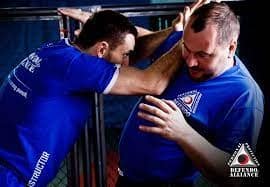
The Defendo Alliance is a European martial arts focused on realistic self-defense training. Schools are primarily located in Scandinavian countries but this association expanding globally (i.e. USA, Ireland, Poland, etc.). Given this organization’s focus on “facing different violent threats that we might confront in the modern society”, it is similar to martial arts such as Krav Maga. In fact, the Defendo Alliance has partnered with a number of Krav Maga schools in the USA.
Read More About Defendo Alliance / Source
Defendu

Close Quarters Combat System (i.e. Defendu) is a modern martial art developed by William E. Fairbairn and Eric A. Sykes prior to World War II. It is a hand-to-hand combat system based on practical experience mixed with Jujutsu and boxing that was developed to train the Shanghai Municipal Police, and was later taught in expanded form to Office of Strategic Services and Special Operations Executive members during World War II.
Read More About Defendu / Source
Drunken Boxing

Drunken boxing (Chinese: 醉拳; pinyin: zuì quán) also known as Drunken Fist, is a general name for all styles of Chinese martial arts that imitate the movements of a drunk person. It is an ancient style and its origins are mainly traced back to the Buddhist and Daoist religious communities. The Buddhist style is related to the Shaolin temple while the Daoist style is based on the Daoist tale of the drunken Eight Immortals. Zui quan has the most unusual body movements among all styles of Chinese martial arts. Hitting, grappling, locking, dodging, feinting, ground and aerial fighting and all other sophisticated methods of combat are incorporated.
Read More About Drunken Boxing / Source
Dumog

Dumog is the Filipino style of wrestling while standing upright and refers to the grappling aspect of Filipino martial arts. The word dumog is most commonly used in Mindanao and the Visayas, while the word buno is used in Luzon, specifically in the Southern Tagalog-speaking provinces as far south as Mindoro. Tribal groups such as the Ifugao, Samal, Ibanag, Manobo, Dumagat, and Maranao are said to practice grappling arts known respectively as bultong, silaga, dama, garong, buteng, purgos, and kapulubod; while ethnic groups such as the Tagalog, Ilokano, Cebuano, Bicolano, Pampanga, and Pangasinan, are said to practice grappling arts known as gabbo, layung, lampugan, pantok, balsakan, and dumog.Techniques encompass a variety of pushes, pulls, weight shifts and joint locks designed to “move” the opponent, often taking advantage of their weight and direction of force to throw them off balance. Dumog is based on the concept of “control points” or “choke points” on the human body, which are manipulated – for example: by grabbing, pushing, pulling – in order to disrupt the opponent’s balance and to keep him off balance. This also creates opportunities for close quarter striking using head butts, knees, forearms and elbows. Dumog also contains methods of joint-locking and choking, as well as takedowns, throws and submission holds. Dumog techniques can be assisted by the environment around you, a wall, lampost or vehicle for example, which helps to immobilise the opponent, or hurt him further by collision with the object. Similarly, Dumog techniques can be used to manipulate an opponent for use as a shield to protect yourself during a multiple attacker scenario, or to quickly move an unwanted person from an area, much like security or law enforcement “come-along” type techniques. Pain compliance is an important aspect of any grappling art. Hence, Dumog techniques can be complemented by nerve point attacks, as well as Kino-mutai which is the term generally used to include pinching, biting, gouging, ripping/tearing methods.Dumog is taught in most Filipino Martial Arts styles as a small addition to their vast syllabus. However, there are a small handful of FMA based systems such as Harimaw Buno, Apolaki Krav Maga & Dirty Boxing and Garimot Buno whose training focuses on training the art of dumog in much more detail.
Read More About Dumog / Source
Enshin Kaikan
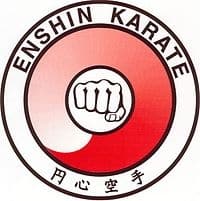
Enshin kaikan (円心会館) is a style of “full contact karate”, or Knockdown karate, founded in 1988 with dojo and students in various countries around the world.
Read More About Enshin Kaikan / Source
Eskrima
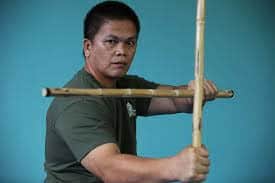
Eskrima (Escrima) is a Filipino martial arts that focuses on the use of sticks, bladed and impact/blunt weapons, improvised weapons, and hand-to-hand (empty hand) techniques. Eskrima is also known as Kali and Arnis. This Philippine martial arts style uses weapons such as a Yantok (fighting stick), Baraw (knife), Bolo (machete), Bankaw (staff), etc. Eskrima is best known for its stick fighting skills.
Read More About Eskrima / Source
Fencing
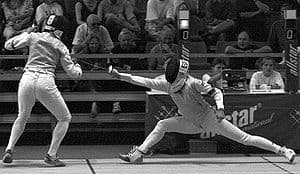
Fencing is a group of three related combat sports. The three disciplines in modern fencing are the foil, the épée, and the sabre (also saber); winning points are made through the weapon’s contact with an opponent. A fourth discipline, singlestick, appeared in the 1904 Olympics but was dropped after that, and is not a part of modern fencing. Fencing was one of the first sports to be played in the Olympics. Based on the traditional skills of swordsmanship, the modern sport arose at the end of the 19th century, with the Italian school having modified the historical European martial art of classical fencing, and the French school later refining the Italian system. There are three forms of modern fencing, each of which uses a different kind of weapon and has different rules; thus the sport itself is divided into three competitive scenes: foil, épée, and sabre. Most competitive fencers choose to specialize in one weapon only.
Competitive fencing is one of the five activities which have been featured in every modern Olympic Games, the other four being athletics, cycling, swimming, and gymnastics.
Read More About Fencing / Source
Fu Jow Pai

Fu Jow Pai (Chinese: 虎爪派, Cantonese Jyutping: Fu2 Zaau2 Pai3, Mandarin pinyin: Hǔ Zhǎo Pài, literally “Tiger Claw School”, also “Tiger Claw System” or “Tiger Claw Style”), originally named “Hark Fu Moon” (Chinese: 黑虎門, Cantonese Jyutping: Hak1 Fu2 Mun4, Mandarin pinyin: Hēihǔmén, literally “Black Tiger School”, also “Black Tiger System”), is a Chinese martial art that has its origins in Hoy Hong Temple out of Tiger techniques of Five Animal Kung Fu, Ng Ying Kungfu (Chinese: 五形功夫). The system “was modeled after the demeanor and fighting strategy of an attacking tiger. Techniques unique to Fu-Jow Pai are ripping, tearing, clawing and grasping applications.”
Read More About Fu Jow Pai / Source
Glima
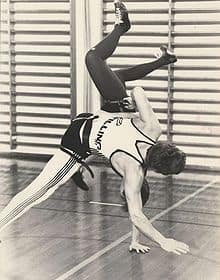
Glima is the name that covers several types of Nordic folk wrestling practiced as sport and combat. In one common form of glima, players grip their opponent by the waist and attempt to throw them to the ground using technique rather than force. Other variants allow for more aggression.
Read More About Glima / Source
GongKwon Yusul
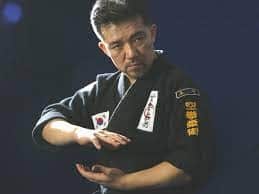
Gongkwon Yusul is a modern Korean martial art system founded by Kang Jun in 1996. Its main influences include the martial arts of Hapkido, Taekwondo, Hakko-ryu Jujutsu, Karate, Judo and Kyuk Too Ki (Korean style Thai Boxing/Shoot Boxing). Gongkwon Yusul is a system which emphasises the application of striking, locking, and throwing techniques in practical, free-flowing fighting situations, rather than the static applications, more in common in traditional styles of Hapkido.
It also varies from Hapkido in that many of its hand techniques are strongly influenced by Western boxing, and that a significant part of Gongkwon Yusul training is in groundwork, applying techniques more akin to judo and Brazilian jiu-jitsu, than most Hapkido styles.
In a sense Gongkwon Yusul is an attempt to combine the practical, free-flowing technique application, often seen in mixed martial arts, whilst still retaining many traditional martial art attributes, such as uniforms, terminology, and ranking structure.
Since its foundation the art has grown rapidly in its home county of Korea with many dojangs around Seoul and also some regional areas of South Korea. This martial art is not widely known outside of Korea; however, there have been dojangs opened in other countries. The first was established in Brazil in 2006, the second in Melbourne in 2007, the third in Launceston, Australia in 2008, the fourth in Gold Coast, Australia in 2008, the fifth in Spain in 2009, the sixth in Brisbane, Australia in 2009, and the seventh in Austin, Texas in 2011, where country music singer/songwriter Willie Nelson earned his fifth degree black belt on April 28, 2014.
Read More About GongKwon Yusul / Source
Haidong Gumdo
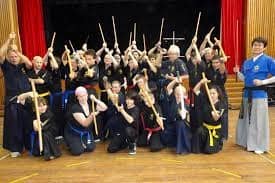
Haidong Gumdo is an elegant and powerful ancient Korean Sword Martial Art. It’s more physically demanding than it looks; it builds great physical, mental and emotional strength. The Samurai of Japan are direct descendents of the Samu Rang of Kokuryo early region of Korea.
Read More About Haidong Gumdo / Source
Hapkido

Hapkido (UK: HAP-kee-DOH,US: hahp-KEE-doh, also spelled hap ki do or hapki-do; from Korean hapgido [hap̚.ki.do]) is a hybrid Korean martial art. It is a form of self-defense that employs joint locks, grappling, throwing techniques, kicks, punches, and other striking attacks. It also teaches the use of traditional weapons, including knife, sword, rope, nunchaku (ssang juhl bong), cane (ji pang ee), short stick (dan bong), and middle-length staff (joong bong), gun (analogous to the Japanese jō), and bō (Japanese), which vary in emphasis depending on the particular tradition examined.
Hapkido employs both long-range and close-range fighting techniques, utilizing jumping kicks and percussive hand strikes at longer ranges, and pressure point strikes, joint locks, and throws at closer fighting distances. Hapkido emphasizes circular motion, redirection of force, and control of the opponent. Practitioners seek to gain advantage over their opponents through footwork and body positioning to incorporate the use of leverage, avoiding the use of brute strength against brute strength.
The art was adapted from Daitō-ryū Aiki-jūjutsu as it was taught by Choi Yong-Sool (최용술) when he returned to Korea after World War II after having lived in Japan for 30 years. This system was later combined by Choi’s disciples with kicking and striking techniques of indigenous and contemporary arts such as Taekkyon, and Tang Soo Do; as well as various throwing techniques and ground fighting from Japanese Judo.
Read More About Hapkido / Source
HEMA
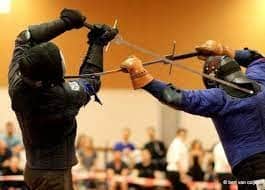
Historical European martial arts (HEMA) are martial arts of European origin, particularly using arts formerly practised, but having since died out or evolved into very different forms.
While there is limited surviving documentation of the martial arts of classical antiquity (such as Greek wrestling or gladiatorial combat), surviving dedicated technical treatises or martial arts manuals date to the Late Middle Ages and the early modern period. For this reason, the focus of HEMA is de facto on the period of the half-millennium of ca. 1300 to 1800, with a German and an Italian school flowering in the Late Middle Ages and the Renaissance (14th to 16th centuries), followed by Spanish, Portuguese, French, English, and Scottish schools of fencing in the modern period (17th and 18th centuries). Arts of the 19th century such as classical fencing, and even early hybrid styles such as Bartitsu may also be included in the term HEMA in a wider sense, as may traditional or folkloristic styles attested in the 19th and early 20th centuries, including forms of folk wrestling and traditional stick-fighting methods.
The term Western martial arts (WMA) is sometimes used in the United States and in a wider sense including modern and traditional disciplines. During the Late Middle Ages, the longsword had a position of honour among these disciplines, and sometimes historical European swordsmanship (HES) is used to refer to swordsmanship techniques specifically.
Modern reconstructions of some of these arts arose from the 1890s and have been practiced systematically since the 1990s.
Hung Ga
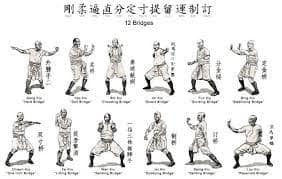
Hung Ga (洪家), Hung Kuen (洪拳), or Hung Ga Kuen (洪家拳) is a southern Chinese martial art belonging to the southern Shaolin styles. The Hallmarks of Hung Ga are strong stances, notably the horse stance or “si ping ma” (四平馬), and strong hand techniques, notably the bridge hand and the versatile tiger claw. Traditionally, students spent anywhere from several months to three years in stance training, often sitting only in horse stance from half an hour to several hours at a time, before learning any forms. Each form could then take a year or so to learn, with weapons learned last. In current times, this mode of instruction is generally considered impractical for students, who have other concerns beyond practicing kung fu. However, some instructors still follow traditional guidelines and make stance training the majority of their beginner training. Hung Ga is sometimes mis-characterized as solely external—that is, reliant on brute physical force rather than the cultivation of qi—even though the student advances progressively towards an internal focus.
Read More About Hung Ga / Source
Huyen Langlon
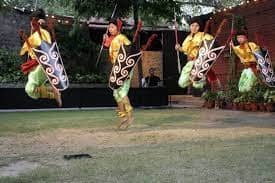
Huyen langlon is an Indian martial art from Manipur. In the Meitei language, huyen means war while langlon or langlong can mean net, knowledge or art. Huyen langlon consists of two main components: thang-ta (armed combat) and sarit sarak (unarmed fighting). The primary weapons of huyen langlon are the thang (sword) and ta (spear). The spear can be used in its non-missile form while in close or thrown from afar. Other weapons include the shield and the axe. Unarmed combat incorporates hand strikes, kicks, and grappling (mukna). Because of Manipur’s cultural similarity and geographical proximity with Myanmar, huyen langlon is closely related to Burmese bando and banshay.
The thang-ta aspect of huyen langlon can be practiced in three ways: ritual, demonstration, and combat. The first way is related to tantric practices and is entirely ritualistic in nature. The second way consists of a spectacular performance involving sword and spear dances. These routines can be converted into actual fighting practices. The third way is the true combat application.
Thang-ta shares a connection with certain war-dances, often blurring the line between dance and combat forms, such as thangkairol (sword dance) and khosarol (spear dance). Many ritualistic dances in Manipur were traditionally performed by martial artists such as the spear dance for funerals or the sacred thengou dance. The sword movements in dance are meant to either symbolize protection or to ward off evil spirits.
Read More About Huyen Langlon / Source
Hwa Rang Do

Hwa Rang Do, also known as “The Way of the Flowering Knights” (Korean: 화랑도; Hanja: 花郞道) is a comprehensive Korean martial art that was developed in the 1960s by Joo Bang Lee and his brother Joo Sang Lee. Hwa Rang Do as a martial art has multiple areas of focus including stand up fighting with open-hand striking, weapons, throws and takedowns, ground fighting, various types of meditative practices, intellectual and character development, and artistic and cultural pursuits.
Read More About Hwa Rang Do / Source
Iaido

Iaidō (居合道), abbreviated with iai (居合), is a Japanese martial art that emphasizes being aware and capable of quickly drawing the sword and responding to sudden attacks.Iaido consists of four main components: the smooth, controlled movements of drawing the sword from its scabbard (or saya), striking or cutting an opponent, removing blood from the blade, and then replacing the sword in the scabbard. While beginning practitioners of iaido may start learning with a wooden sword (bokken) depending on the teaching style of a particular instructor, most of the practitioners use the blunt edged sword, called iaitō. Few, more experienced, iaido practitioners use a sharp edged sword (shinken).Practitioners of iaido are often referred to as iaidoka.
Read More About Iaido / Source
Inbuan Wrestling

Inbuan is a form of wrestling native to the people of Mizoram in India. Inbuan is said to have originated in the village of Dungtlang in 1750. It was recognized as a sport after the Mizo people migrated from Burma to the Lushai Hills.
Read More About Inbuan Wrestling / Source
Jailhouse Rock
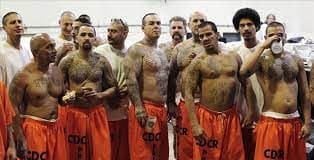
Jailhouse rock or 52 Hand Blocks is a name used to describe a collection of fighting styles that were practiced or developed within black urban communities in the 1960s and 1970s. It has a mythological origin story of having been originated with the US penal institutions back in the 1960s and 1970s, but despite the origin story the teaching of fighting systems by inmates are not allowed.
Today Jailhouse Rock is more commonly known and referred to as “52 Hand Blocks” or “52”.
There is many different manifestations of 52 Hand Blocks but they all share a commonality in blending western boxing with other stylised martial arts techniques. The origins of 52 Hand Blocks, although highly debated, coincide with golden era of martial arts in America when Chinese cinema was booming.
The name 52 Hand Blocks, although contested, is most likely derived from the reference of the fifty-two blocking techniques encompassed in the art. These techniques consist of traditional western boxing blocks, covers and parry’s but also include offensive elbows, elbow blocks, knees, head butts and other martial arts techniques.
Jailhouse Rock or 52 Hand Blocks is comparable to French Savate. Originally it was a semi-codified fighting method associated with an urban criminal subculture, and later it gradually underwent a process of codification before becoming an established martial art accessible to the cultural mainstream.
52 Hand Blocks has been referenced numerous times by contemporary media including by journalist Douglas Century’s Street Kingdom: Five Years Inside the Franklin Avenue Posse, as well as numerous Wu-Tang Clan songs and Ted Conover’s book Newjack. Recently, celebrities including actor Larenz Tate and rapper Ludacris have taken up the fighting system for film roles and self-defense, shining a brighter light on this previously underground martial art.
Read More About Jailhouse Rock / Source
Jojutsu
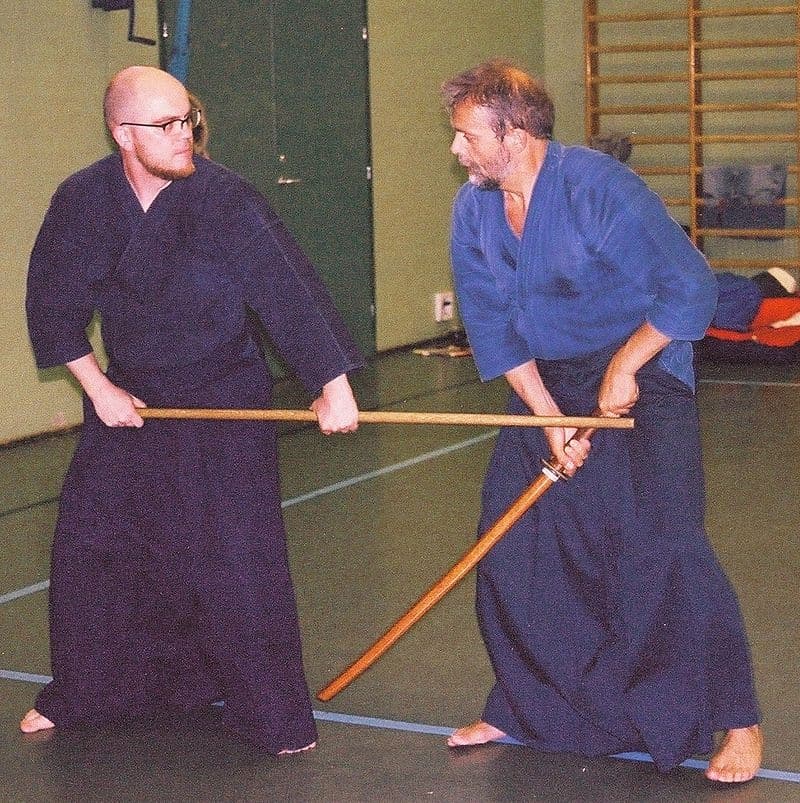
Jōdō (杖道), meaning “the way of the jō”, or Jōjutsu (杖術) is a Japanese martial art using a short staff called jō. The art is similar to bōjutsu, and is strongly focused upon defense against the Japanese sword. The jō is a short staff, usually about 3 to 5 feet (0.9 to 1.5 m) long.
Read More About Jojutsu / Source
Juttejutsu
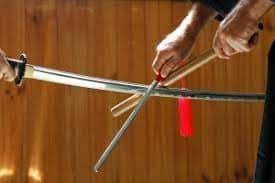
Juttejutsu is a Japanese martial arts that focuses on training with a traditional martial arts weapon known as the Jutte (or Jitte). The Jutte is a two pronged baton and is similar to the Sai.
In ancient Japan, the Jutte was used by retainers in situations where swords were prohibited. The Jutte was used to block knife/sword strikes, hit opponents with the shaft, etc.
Today, according to Shindo Muso Ryu Jodo, Juttejutsu focuses on “24 core jutte kata”. In these katas, the Jutte is often used in conjunction with the Tessen (or war fan).
Read More About Juttejutsu / Source
Kajukenbo
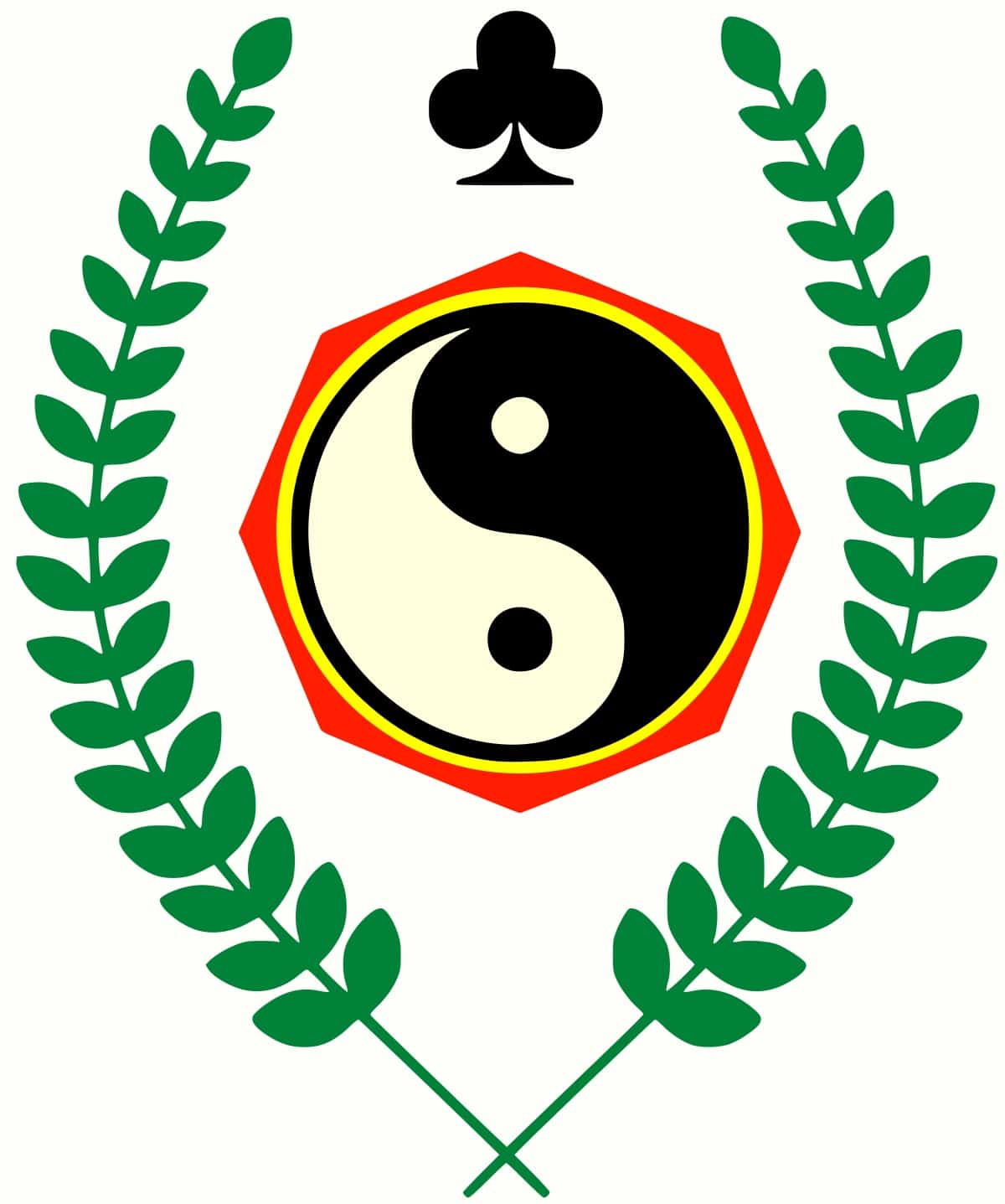
Kajukenbo (Japanese: カジュケンボ Kajukenbo) is a hybrid martial art from Hawaii. It was developed in the late 1940s and founded in 1947 in the Palama Settlement of Palama, Hawaii.
The name Kajukenbo is a combination of the various arts from which its style is derived: KA for Karate, JU for Judo and Jujutsu, KEN for Kenpo and BO for Boxing (Kajukenbo). Kajukenbo training incorporates a blend of striking, kicking, throwing, takedowns, joint locks and weapon disarmament.Today, Kajukenbo is practiced all over the world in many different branches (examples like Holck McCarrell Branch Kajukenbo Juijitsu, just for reference). In contrast to many traditional martial arts, students are not required to mimic their teacher, but are encouraged to develop their own “expression” of the art after they first master the system.
Read More About Kajukenbo / Source
Kalaripayattu
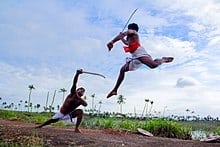
Kalaripayattu, IPA: [kɐɭɐɾip:ɐjɐt:ɨ̆]; also known simply as Kalari, is an Indian martial art that originated in modern-day Kerala, a state on the southwestern coast of India. Kalaripayattu is known for its long-standing history within Indian martial arts. It is believed to be the oldest surviving martial art in India, with a history spanning over 3,000 years.Kalaripayattu is mentioned in the Vadakkan Pattukal, a collection of ballads written about the Chekavar of the Malabar region of Kerala. In the Vadakkan Pattukal, it is stated that the cardinal principle of Kalaripayattu was that knowledge of the art be used to further worthy causes, and not for the advancement of one’s own selfish interests. Kalaripayattu is a martial art designed for the ancient battlefield (the word “Kalari” meaning “battlefield”), with weapons and combative techniques that are unique to India.
Like most Indian martial arts, Kalaripayattu contains rituals and philosophies inspired by Hinduism. The art also bases medical treatments upon concepts found in the ancient Indian medical text, the Ayurveda. Practitioners of Kalaripayattu possess intricate knowledge of pressure points on the human body and healing techniques that incorporate the knowledge of Ayurveda and Yoga. Kalaripayattu is taught in accordance with the Indian guru-shishya system. Kalaripayattu differs from many other martial arts systems in the world in that weapon based techniques are taught first, and barehanded techniques are taught last.Elements from the yoga tradition as well as finger movements in the nata dances, were incorporated into Kalaripayattu. A number of South Asian fighting styles remain closely connected to yoga, dance and performing arts. Some of the choreographed sparring in Kalaripayattu can be applied to dance and Kathakali dancers who knew Kalaripayattu were believed to be markedly better than other performers. Some traditional Indian classical dance schools still incorporate martial arts as part of their exercise regimen.Kalaripayattu includes strikes, kicks, grappling, preset forms, weaponry and healing methods. Warriors trained in Kalaripayattu would use very light, and basic body armor, as it was difficult to maintain flexibility and mobility while in heavy armor.
Unlike other parts of India, warriors in Kerala belonged to all castes. Women in Keralite society also underwent training in Kalaripayattu, and still do so to this day. Keralite women such as Unniyarcha are mentioned in a collection of ballads from Kerala called the Vadakkan Pattukal, and are praised for their martial prowess.
Read More About Kalaripayattu / Source
Kalenda
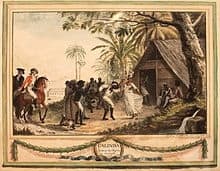
Calinda (also spelled kalinda or kalenda) is a martial art, as well as kind of folk music and war dance in the Caribbean which arose in the 1720s. It was brought to the Caribbean by Africans In the transatlantic slave trade and is based on native African combat dances.
Calinda is the French spelling; the Spanish equivalent is calenda.
Read More About Kalenda / Source
Kamau Njia
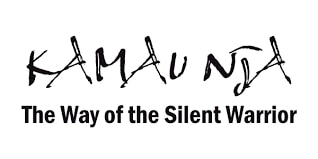
Kamau Njia is one of the most innovative and practical systems of self defense taught today. Kamau Njia specializes in teaching defensive tactics ranging from the use of non-lethal force to survival tactics. It is the perfect method for men, women, and children of all ages, sizes, and strength.
Kamau Njia is based on instinctive movement, practical concepts, and sound principles. This is coupled with the ability to develop skills from an individuals natural defensive and offensive movements. These skills are thoroughly enhanced through “REAL TIME” training scenarios against grabs, strikes, weapons, and ground attacks. Through these training scenarios, students are better prepared to function during the pressure and distress of violent attacks.
Read More About Kamau Njia / Source
Kapap

Kapap (Hebrew: קפ”פ, קפא”פ), often written KAPAP, a Hebrew acronym for Krav Panim el Panim (lit. face-to-face combat), is a close-quarter battle system of defensive tactics, hand-to-hand combat and self-defense.
Read More About Kapap / Source
Kenpo
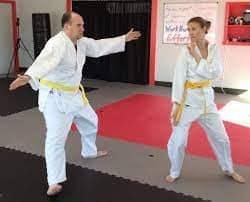
Kenpō (Japanese: 拳法) is the name of several Japanese martial arts. The word kenpō is a Japanese translation of the Chinese word “quánfǎ”. This term is often informally transliterated as “kempo”, as a result of applying Traditional Hepburn romanization, but failing to use a macron to indicate the long vowel. The generic nature of the term combined with its widespread, cross-cultural adoption in the martial arts community has led to many divergent definitions. The word Kenpō translates thus: “Ken” meaning ‘Fist’ and “Po” meaning ‘Method’ or ‘Law’ as in ‘Law of gravity’, a correct interpretation of the word Kenpō would be ‘Fist Method’, the same meaning as ‘Quanfa’. However, it is often misinterpreted as ‘the Law of the Fist’, which appeals to those looking for a more ‘imposing’ or aggressive sounding name.
Read More About Kenpo / Source
Keysi Fighting Method
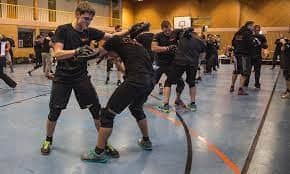
The Keysi Fighting Method is a self-defense system “created to act and react while defending yourself”. This martial arts system has been featured in movies such as the Batman series (with Christian Bale) and Jack Reacher (with Tom Cruise).
According to the Keysi Instructor World Map, this system has a number of instructors in Europe. However, there are relatively few instructors in other geographical locations.
Read More About Keysi Fighting Method / Source
Kinamutay

Kinamutay (Cebuano: kinamutay, lit. “effeminate hand fighting”; Tagalog: kinamotay; Baybayin: ᜊᜒᜈᜋᜓᜆᜌ᜔), commonly but incorrectly orientalized kino mutai, is a specialized subsection of some martial arts that emphasizes biting, pinching, eye-gouging, and other forms of “dirty” fighting techniques. Kinamutay involves extensive use of grappling and manipulation of nerve and pressure points, so as to allow the kinamutay practitioner to inflict pain and control the opponent while applying the techniques. Although in Cebu it is culturally associated with women’s catfighting, the techniques used are effective against opponents of all sizes.
The root word of the term is Cebuano kinamut, “using the hands” (such as in eating food), from kamut, “hand” (and compare related Tagalog kamot, “to scratch”), with the feminizing suffix -ay. Formalization of kinamutay as a martial art is a Western tradition not founded in Filipino martial arts or culture, where the term has little difference in meaning from “catfight”. It was popularized in the magazine Black Belt in the late 1980s, especially by martial artist Paul Vunak; it is also associated with Jeet Kune Do.One key principle is uninterrupted biting: This means that the kinamutay practitioner places himself in such a position that he can continue to hold a bite as long as he wants, disabling his opponent from escaping his bite. The biting aspect of kinamutay concerns itself with what targets to bite, how much to bite at a time, and the angle and movement of the bite. Favored targets include sensitive and easily accessible areas such as the face, neck, ear, groin, nipple, and latissimus dorsi muscle. These targets are also chosen over others because of the difficulty countering a kinamutay practitioner biting them, ensuring an uninterrupted bite can take place. It can be used to inflict pain and can be used to cut arteries which can cause severe bleeding.
Read More About Kinamutay / Source
Kinomichi
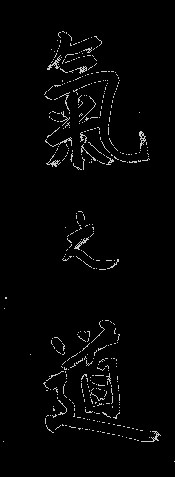
Kinomichi (氣之道) is a martial art in the tradition of budō, developed from the Japanese art aikido by Masamichi Noro and founded in Paris, France, in 1979. Masamichi Noro was one of the live-in students (uchideshi) of Morihei Ueshiba, the founder of aikido. Designated “Delegate for Europe and Africa” by Morihei Ueshiba, Noro debarked in Marseille on September 3, 1961, preceding Nakazono and Tamura in the communal construction of a European and African aikido. In France, Kinomichi is affiliated with the Fédération Française d’Aïkido, Aïkibudo et Affinitaires (FFAAA) and maintains warm relations with the Aikikai Foundation and its leader, Moriteru Ueshiba, the grandson of aikido’s founder.
Read More About Kinomichi / Source
Krabi-Krabong
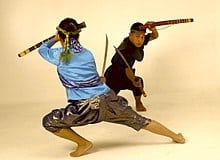
Krabi-Krabong (Thai: กระบี่กระบอง, pronounced [krā.bìː krā.bɔ̄ːŋ]) is a weapon-based martial art from Thailand. It is closely related to other Southeast Asian fighting styles such as Malay silat, Burmese banshay and Cambodian kbach kun boran. The royal bodyguard corps of the late King Bhumibol Adulyadej (Rama IX) were said to be highly trained in krabi-krabong.
Read More About Krabi-Krabong / Source
Kuk Sool Won
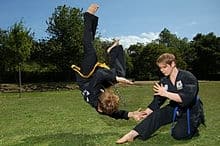
Kuk Sool Won (Korean: 국술원; Hanja: 國術院) is a type of Korean martial arts. It was founded in 1958 by Suh In-Hyuk (서인혁), who also carries the formal titles of, Kuk Sa Nim (i.e. “national teacher”) and Grandmaster.This Korean martial art is known for its comprehensive collection of combat techniques, in particular, it teaches an extensive set of offensive and defensive moves designed to take advantage of the human body’s many pressure points.Kuk Sool Won is practiced in various countries, with its biggest bases other than the ROK and the USA being Western Europe (Germany, France, Italy and Spain) and Iran. However there is a strong following in South America as well.
Read More About Kuk Sool Won / Source
Kumdo
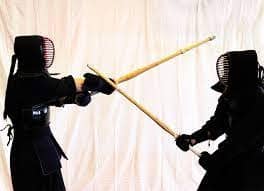
Kumdo is a modern Korean martial art derived from Japanese Kendo. Though romanized in a number of ways when written, Kǒmdo or Geomdo, the meaning remains “the way of the sword” and is cognate with the Japanese term. As a martial art, Kumdo has become accepted in Korean culture and society since its introduction from Japan to the degree that the term “kumdo” has, in recent history, become a generic label for other Korean martial arts based upon Korean Swordsmanship. Therefore, kumdo can apply to the sporting and competitive form of swordsmanship, similar to Kendo, or it can be applied to other martial forms of Korean swordsmanship such as Haidong Gumdo or Hankumdo. Although related to Japanese Kendo, minor differences exist in Korean Kumdo due to appropriation and acculturation. Such differences include, but are not limited to, the use of native terminology, the use of blue flags rather than red flags for the referees and minor modifications to the uniform.
Read More About Kumdo / Source
Kung Fu To'a
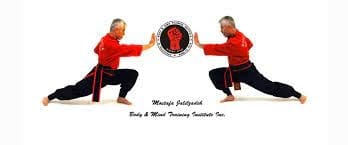
Kung Fu To’a is an Iranian martial arts style that combines Kung Fu and Yoga. This modern martial arts was created in the 1950s by Ibrahim Mirzaei. Kung Fu To’a is one of most popular martial arts in Iran.
According to the World Kung Fu To’a Federation, “To’a training essentially depends on mastering combative forms (khat), which are unarmed as well as armed, with particular emphasis on physical and mental health and meditation practices… Kung Fu To’a consists of about 73.000 techniques, combinations and reactions. Dynamic wavelike movements and strong accentuation of techniques (called shock), frequently finished by a twist are characteristic for this martial art”.
Read More About Kung Fu To'a / Source
Kuntao
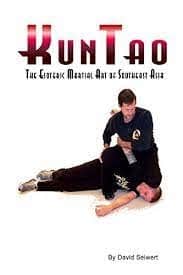
Kuntao or kuntau (拳道, Pe̍h-ōe-jī: kûn-thâu, Tagalog: kuntaw) is a Hokkien term for the martial arts of the Chinese community of Southeast Asia, specifically the Malay Archipelago. It is most commonly practiced in and associated with Indonesia, Malaysia, the Philippines and Singapore.
Read More About Kuntao / Source
Kyokushin
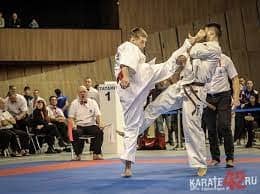
Kyokushin (極真) is a full-contact martial art, school of Karate originating from Japan. It is a style of stand-up fighting and is rooted in a philosophy of self-improvement, discipline and hard training.Kyokushin Kaikan is the martial arts organization founded in 1964 by Korean-Japanese Masutatsu Oyama (大山倍達, Ōyama Masutatsu), officially the International Karate Organization. Previously this institution was known as the Oyama Dojo.
Read More About Kyokushin / Source
Kyudo
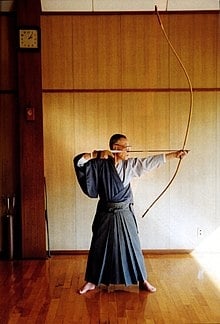
Kyūdō (Japanese: 弓道) is the Japanese martial art of archery. High level experts in kyūdō may be referred to as kyūdōka (弓道家), and some practitioners may refer to themselves as yumihiki (弓引き), ‘bow puller’. Kyūdō is based on kyūjutsu (“art of archery”), which originated with the samurai class of feudal Japan. Kyūdō is practised by thousands of people worldwide. As of 2005, the International Kyudo Federation had 132,760 graded members.
Read More About Kyudo / Source
Kyujutsu
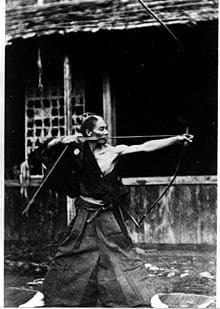
Kyūjutsu (弓術) (“art of archery”) is the traditional Japanese martial art of wielding a bow (yumi) as practiced by the samurai class of feudal Japan. Although the samurai are perhaps best known for their swordsmanship with a katana (kenjutsu), kyūjutsu was actually considered a more vital skill for a significant portion of Japanese history. During the majority of the Kamakura period through the Muromachi period (c.1185–c.1568), the bow was almost exclusively the symbol of the professional warrior, and way of life of the warrior was referred to as “the way of the horse and bow” (弓馬の道, kyūba no michi).
Read More About Kyujutsu / Source
Kyuk Too Ki
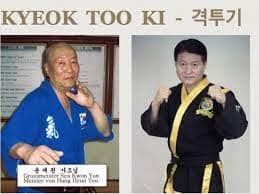
Kyuk Too Ki is a Korean martial arts that combines elements of Muay Thai and Taekwondo. This is a full contact sport and involves punches, kicks, elbow strikes, knee strikes, etc.
This martial arts is also known as Kun Gek Do, Korean Kickboxing, etc.
Read More About Kyuk Too Ki / Source
Laamb

Senegalese wrestling (Njom in Serer, Lutte sénégalaise or simply Lutte avec frappe in French, Laamb in Wolof, Siɲɛta in Bambara) is a type of folk wrestling traditionally performed by the Serer people and now a national sport in Senegal and parts of The Gambia, and is part of a larger West African form of traditional wrestling (fr. Lutte Traditionnelle). The Senegalese form traditionally allows blows with the hands (frappe), the only one of the West African traditions to do so. As a larger confederation and championship around Lutte Traditionnelle has developed since the 1990s, Senegalese fighters now practice both forms, called officially Lutte Traditionnelle sans frappe (for the international version) and Lutte Traditionnelle avec frappe for the striking version.
Read More About Laamb / Source
Lathi Khela
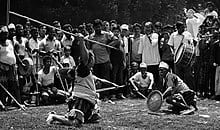
Lathi khela (Bengali: লাঠি খেলা) is a traditional Bengali martial art – a kind of stick fighting practised India and Bangladesh. A practitioner is known as a lathial.
Read More About Lathi Khela / Source
Lerdrit

Ler Drit, Leert Rit, or Muay Leert Rit (มวย Muay: boxing, fighting เลิศ leert: superior, excellent ฤทธิ์ rit: formidable force, colossal power) is the generic name attributed to the set of principles and fighting techniques employed by Siamese warriors for centuries on South East Asian battlefields. This form of Muay has been used primarily by the Royal Thai Army‘s Palace Guard, the Capital’s Defense Corps, war elephants’ Defense Units and Special Infantry Corps. Siamese Lert Rit was based on a clever combination of the Nine Natural Weapons (Nawarthawooth), i.e., hands, feet, knees, elbows and head, which were used to attack and defend. It was also based on the four ancestral strategies used by Special Infantry Corps: Tum (throwing to the ground), Tap (crush), Chap (grab), Hak (break the joints). the technical background has been systematized and updated, in order to be applied by civilians. Muay of today is a traditional martial art born from the ancestral precepts of Siamese warriors, adapted to the self-defence needs of modern practitioners, regardless of their physical characteristics and the conditions under which its techniques are applied.
Read More About Lerdrit / Source
Limalama

Limalama is a Polynesian art of self-defense, created and founded by Tu’umamao “Tino” Tuiolosega (1931–2011). Tuiolosega created the word “Limalama” as a portmanteau derived from the Samoan language words lima (hand) and malamalama (understanding). Tuiolosega defined Limalama to mean “knowledge and understanding”, and translated it as “hand of wisdom”.
Read More About Limalama / Source
Lua

Lua is a traditional Hawaiian martial arts that focuses on bone breaking, boxing, wrestling, weapons, etc.
According to Lua Hâlau O Kaihewalu, Lua utilizes “Peku (a variety of kicks), Paa Lima (hand catch and trap), Hikua (throws), Ku’i Ku’i (boxing; a variety of punches), Waho/Loko Hio (a variety of leg sweeps), Ihe Manamana Lima (finger spear poking), Pahu/Huki (push and pull), Nahu Waha (biting with the mouth), Ku’i (punch, poke), and Mokomoko (rough, dirty, everything goes fighting)”.
Luta Livre
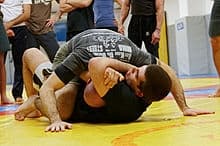
Luta Livre (Portuguese: [ˈlutɐ ˈlivɾi], lit. freestyle fighting), known in Brazil as Luta Livre Brasileira (lit. Brazilian freestyle fighting) and also Brazilian Submission Wrestling,or Luta Livre Submission is a Brazilian martial art created by Euclydes Hatem in Rio de Janeiro. Primarily a mixture of catch wrestling and kosen judo, there is also striking with the hands, feet, knees and elbows. Notable practitioners include Marco Ruas, Ebenezer Fontes Braga, Johil de Oliveira, Alexandre Franca Nogueira, Renato Sobral, Gesias Cavalcante, Darren Till and José Aldo.
There are two styles: esportiva (“sporting”) and vale tudo (“anything goes”); both styles are no-gi. In esportiva competitions, grappling techniques are the only techniques allowed to subdue the opponent. Consequently, it is important to calmly strategize and execute moves with the aim to force the opponent to submit via armlock, leglock, choke or necklock, or to win by points (i.e. takedowns, domination position). Punches, kicks and other “hard” techniques are not allowed as this is considered more a sport than actual combat. Vale tudo, on the other hand, includes techniques in the clinch as well as on the ground; punches and kicks are allowed, but the ground fight and submissions are still the largest elements. This is also the form used in MMA-style fights.
Read More About Luta Livre / Source
Malla-Yuddha
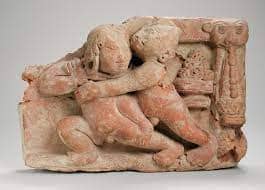
Malla-yuddha (Sanskrit: मल्लयुद्ध, IAST: mallayuddha) is the traditional form of combat-wrestling originating in India. It is closely related to Southeast Asian wrestling styles such as naban and is one of the two ancestors of kushti. Indian wrestling is described in the 13th century Malla Purana.
Malla-yuddha incorporates wrestling, joint-breaking, punching, biting, choking and pressure point striking. Matches were traditionally codified into four types which progressed from purely sportive contests of strength to actual full-contact fights known as yuddha. Due to the extreme violence, this final form is generally no longer practised. The second form, wherein the wrestlers attempt to lift each other off the ground for three seconds, still exists in south India. Additionally, malla-yuddha is divided into four categories (see below). Each yuddhan is named after Hindu gods and legendary fighters:
Hanumanti – concentrates on technical superiority.
Jambuvanti – uses locks and holds to force the opponent into submission.
Jarasandhi – concentrates on breaking the limbs and joints while fighting.
Bhimaseni – focuses on sheer strength.
Read More About Malla-Yuddha / Source
Mani
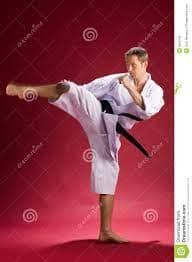
Juego de maní (‘game of war’) often simply called maní or mani, sometimes referred to as baile de maní (‘dance of war’) or bambosa, is a combined martial art and dance that was developed in Cuba by African slaves. It has its roots in the Kongo-Angola culture and is still kept alive today in Cuba by folkloric groups. Practitioners are referred to as maniseros.
Marine Corps Martial Art Program
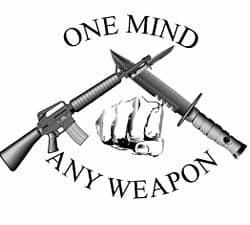
The Marine Corps Martial Arts Program (MCMAP, ) is a combat system developed by the United States Marine Corps to combine existing and new hand-to-hand and close quarters combat techniques with morale and team-building functions and instruction in the warrior ethos. The program, which began in 2001, trains Marines (and U.S. Navy personnel attached to Marine units) in unarmed combat, edged weapons, weapons of opportunity, and rifle and bayonet techniques. It also stresses mental and character development, including the responsible use of force, leadership, and teamwork.
Read More About Marine Corps Martial Art Program / Source
Mau Rakau

Mau rākau, meaning “to bear a weapon”, is a martial art based on traditional Māori weapons.
Read More About Mau Rakau / Source
Muay Boran
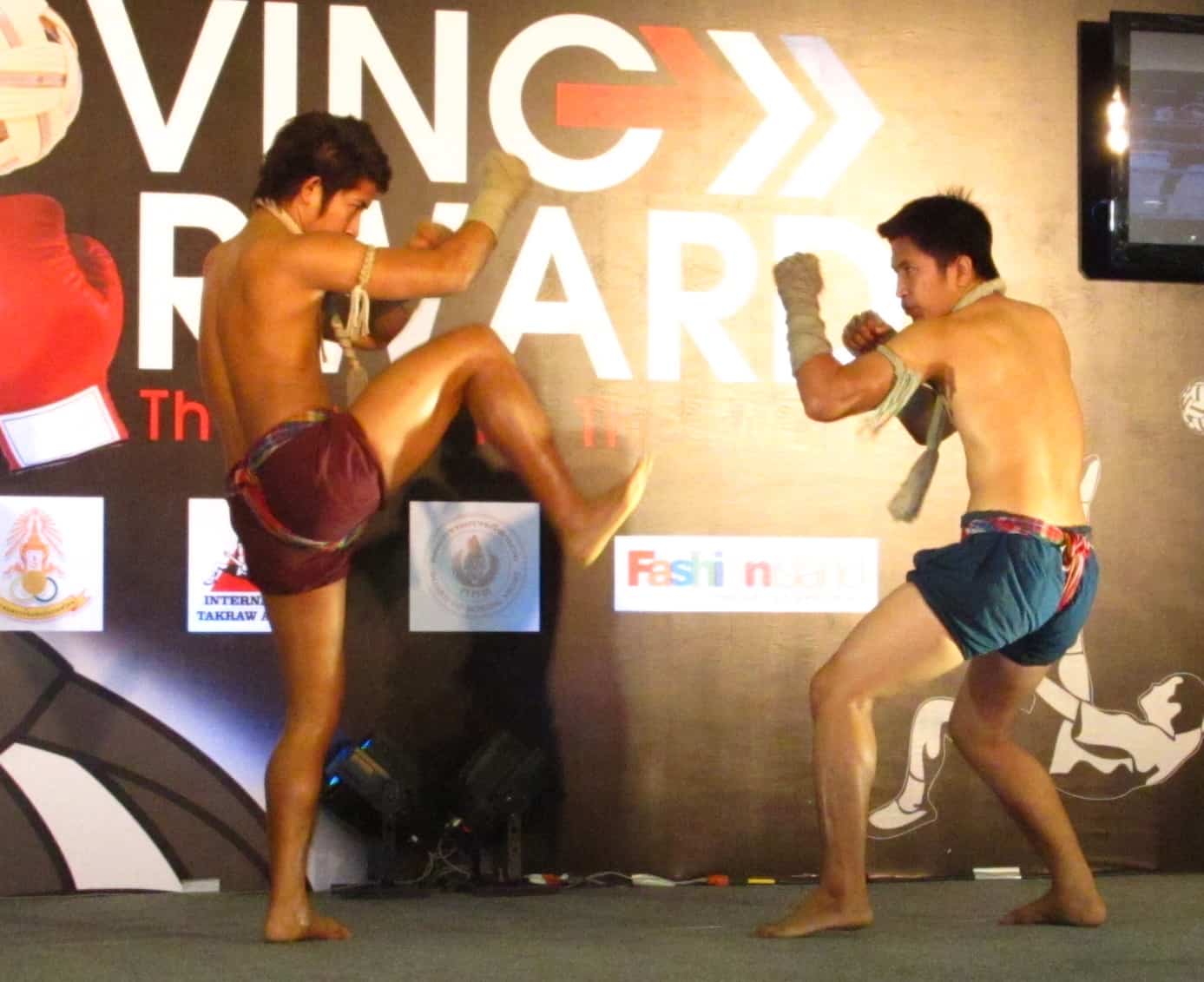
Muay Boran (Thai: มวยโบราณ, RTGS: muai boran, pronounced [mūa̯j bōːrāːn], lit. “ancient boxing”) or originally Toi Muay (ต่อยมวย) is an umbrella term for the unarmed martial arts of Thailand prior to the introduction of modern equipment and rules in the 1930s.
Read More About Muay Boran / Source
Musti Yuddha

Musti-Yuddha (Sanskrit and Hindi: मुष्टि युद्ध; Urdu: مُشٹی یُدّھاَ) is a traditional combat sport originating from the Indian subcontinent. The term literally means “fist combat”, from the Sanskrit words muṣṭi (fist) and yuddha (fight, battle, conflict). While this would originally have been used as a general term for any boxing art, today it usually refers to muki boxing from Varanasi, the only surviving unarmed style. In the Punjab there still exists an armed form of boxing called loh-musti in which the fighters wear an iron ring on one hand, although it is no longer used for sparring.
Aspiring fighters undergo years of apprenticeship, toughening their fists against stone and other hard surfaces, until they are able to break coconuts and rocks with their bare hands. Any part of the body may be targeted, except the groin, but the prime targets are the head and chest. Techniques incorporate punches, kicks, elbows, knees and grabs. Boxers wear no form of protection and fight bare-fisted. Matches may be one-on-one, one against a group, or group against group. Victory can be attained by knockout, ringout or submission.
The martial art is related to other forms of martial arts found in other parts of the Indian cultural sphere including Muay Thai in Thailand, Muay Lao in Laos, Pradal Serey in Cambodia and Lethwei in Myanmar.
Read More About Musti Yuddha / Source
Naginatajutsu
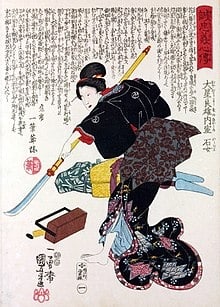
Naginatajutsu (長刀術 or 薙刀術) is the Japanese martial art of wielding the naginata (長刀). This is a weapon resembling the medieval European glaive and the Chinese guan dao. Most naginatajutsu practiced today is in a modernized form, a gendai budō, in which competitions also are held.
Read More About Naginatajutsu / Source
Nhat Nam

Nhất Nam is a martial art originating from Vietnam, formalised in Hanoi from 1983 onwards by Ngô Xuân Bính.The name Nhất Nam derives from Sino-Vietnamese characters from “One South” (一南), and is to be distinguished from Nhật Nam (“Sun South” 日南), the Vietnamese name for the ancient Chinese Rinan Han commandery in northern Vietnam. The “One” expresses the “unification” of features of Vietnamese martial arts. Ngô Xuân Bính formalised these features in his book on the basics of this unified approach in “Nhất Nam căn bản” Volumes 1 and 2, (“Basic Nhất Nam,” căn bản means “basic.”)
According to the English Nhất-Nam Federation’s website “Nhất-Nam was mentioned for the first time in sources dating from the thirteenth and fourteenth centuries.” However Vietnamese sources generally refer that the techniques were recorded centuries earlier, but the specific “One-Nam” name dates the art to 1983.
Nhat Nam was established in Russia in the 1990s and is also practised in Lithuania, Belarus, Ukraine, Switzerland, and the UK.Nhất Nam is mentioned in the novel The Zenith (set in the final months of Ho Chi Minh’s life) by Vietnamese author Duong Thu Huong.
Read More About Nhat Nam / Source
Nippon Kempo

Nippon Kempo (日本拳法) is a Japanese martial art, practised wearing protective gear (face, body, crotch, etc.) and gloves and allows full use of stand-up striking, throwing, and ground fighting.
It was founded and created by Muneomi Sawayama in 1932. Sawayama was a judoka who had studied under Kenwa Mabuni, a karateka who would establish the Shito-Ryu school of Karate. There are multiple schools and groups based on the Nippon Kempo Association launched by Sawayama, and each has its own rules.
Read More About Nippon Kempo / Source
Niten Ichi-Ryu

Niten Ichi-ryū (二天一流), which can be loosely translated as “the school of the strategy of two heavens as one”, is a koryū (ancient school), transmitting a style of classical Japanese swordsmanship conceived by the warrior Miyamoto Musashi. Hyōhō Niten Ichi-ryū is mainly known for the two-sword—katana and wakizashi—kenjutsu techniques Musashi called Niten Ichi (二天一, “two heavens as one”) or Nitō Ichi (二刀一, “two swords as one”).
Read More About Niten Ichi-Ryu / Source
Niyuddha
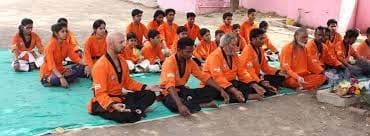
नियुध एक प्राचीन भारतीय मार्शल आर्ट है जो लात मारने, मुक्का मारने और फेंकने पर केंद्रित है। नियुध को “जटिल कला रूप, एक रोमांचक खेल और शारीरिक और मानसिक फिटनेस बनाए रखने की एक विधि” के रूप में भी देखा जाता है। इस मार्शल आर्ट शैली में मध्यस्थता का एक बड़ा हिस्सा शामिल है।
Read More About Niyuddha / Source
Northern Praying Mantis

Northern Praying Mantis (Chinese: 螳螂拳; pinyin: tánglángquán; lit. ‘praying mantis fist’) is a style of Chinese martial arts, sometimes called Shandong Praying Mantis after its province of origin. It was created by Wang Lang (王朗) and was named after the praying mantis, an insect, the aggressiveness of which inspired the style. One Mantis legend places the creation of the style in the Song Dynasty when Wang Lang was supposedly one of 18 masters gathered by the Abbot Fu Ju (福居), a legendary persona of the historical Abbot Fu Yu (福裕) (1203–1275), to improve Shaolin martial arts. However, most legends place Wang Lang in the late Ming Dynasty.
Read More About Northern Praying Mantis / Source
Nunchaku
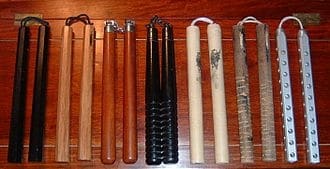
The nunchaku () (Japanese: ヌンチャク, sometimes “nunchuks” (), “nunchucks”, “chainsticks”, “chuka sticks” or “karate sticks” in English,) is a traditional Okinawan martial arts weapon consisting of two sticks (traditionally made of wood), connected to each other at their ends by a short metal chain or a rope. A person who has practiced using this weapon is referred to in Japanese as nunchakuka.
The nunchaku is most widely used in martial arts such as Okinawan kobudō and karate. It is intended to be used as a training weapon, since practicing with it enables the development of quick hand movements and improves posture. Modern nunchaku may be made of metal, plastic or fiberglass instead of the traditional wood. Toy versions and replicas not intended to be used as weapons may be made of polystyrene foam or plastic. Possession of this weapon is illegal in some countries, except for use in professional martial arts schools.
The origin of the nunchaku is unclear; a traditional explanation holds that it was were originally used by Okinawan farmers as a rice-flail (for threshing rice). Another weapon, called the tabak-toyok, native to the northern Philippines, is constructed very similarly, suggesting that it and the nunchaku descended from the same instrument. Even in the old days, when the nunchaku was used as a weapon, it was never widely popular, because it was ineffective against more widely used weapons of the time, such as katana and naginata – and little information about techniques for its use as a weapon survive.
In modern times, the nunchaku (Tabak-Toyok) was popularized by the actor and martial artist Bruce Lee and by Dan Inosanto, who both learned Japanese martial arts from Lee and taught him Filipino martial arts – and who introduced the actor to the nunchaku. Lee famously used nunchaku in several scenes in the 1972 film Fist of Fury. When Tadashi Yamashita worked with Bruce Lee on the 1973 film Enter the Dragon, he enabled Lee to further explore the use of the nunchaku and other kobudo disciplines. The nunchaku is also the signature weapon of the cartoon character Michelangelo in the Teenage Mutant Ninja Turtles franchise.
In addition the nunchaku is used in certain contact sports.
Read More About Nunchaku / Source
Okinawan Kobudo
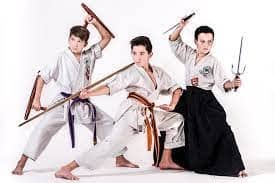
Okinawan Kobudō (沖縄古武道), literally “old martial way of Okinawa”, is the weapon systems of Okinawan martial arts.
Read More About Okinawan Kobudo / Source
Panantukan
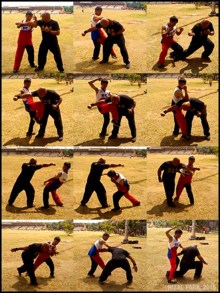
Suntukan is the fist-related striking component of Filipino martial arts. In the central Philippine island region of Visayas, it is known as Pangamot or Pakamot and Sumbagay. It is also known as Mano-mano and often referred to in Western martial arts circles of Inosanto lineage as Panantukan. Although it is also called Filipino Boxing, this article pertains to the Filipino martial art and should not be confused with the Western sport of boxing as practiced in the Philippines. In recent times, suntukan has become a generalized term for any brawls in the Philippines, with the term panantukan becoming more frequently used to denote the actual martial art.
Read More About Panantukan / Source
Pankration

Pankration (; Greek: παγκράτιον) was a sporting event introduced into the Greek Olympic Games in 648 BC, which was an empty-hand submission sport with few rules. The athletes used boxing and wrestling techniques, but also others, such as kicking, holds, joint-locks, and chokes on the ground, making it similar to modern mixed martial arts.
The term comes from the Greek παγκράτιον [paŋkrátion], meaning ‘all of power’, from πᾶν (pan) ‘all’ and κράτος (kratos) ‘strength, might, power’.
Read More About Pankration / Source
Phelwani
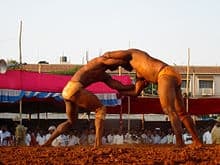
Pehlwani, also known as kushti, is a form of wrestling contested in the Indian subcontinent. It was developed in the Mughal Empire by combining Persian koshti pahlevani with influences from native Indian malla-yuddha. The words pehlwani and kushti derive from the Persian terms pahlavani (heroic) and koshti (wrestling, lit. killing) respectively, meaning Heroic wrestling. A practitioner of this sport is referred to as a pehlwan (Persian originated word for hero) while teachers are known as ustad (Persian word for teacher or master).One of the most famous practitioners of pehlwani was The Great Gama (Ghulam Mohammad Baksh Butt), who is considered one of the greatest wrestlers of all time. Kodi Rammurthy Naidu was another example. Brahmdev Mishra was also a great example of Indian wrestler who was known for his technique and physique not only in India but all over the world. Pehlwani is one among the sports that influenced catch wrestling, which in turn partially inspired folkstyle wrestling, freestyle wrestling, and mixed martial arts (MMA).
Read More About Phelwani / Source
Pradal Serey
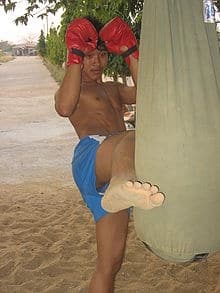
Pradal Serey (Khmer: ប្រដាល់សេរី) or Kun Khmer (Khmer: គុនខ្មែរ) is an unarmed martial art and combat sport from Cambodia. It is a martial art practiced by young, athletic people. The official Khmer name of the sport is Kbach Kun Pradal Khmer. In Khmer, pradal means fighting or boxing and serey means free. Thus, pradal serey may be translated as “free fighting” or “free boxing”. The sport consists of stand up striking and clinch fighting where the objective is to knock an opponent out, force a technical knockout, or win a match by points.
Pradal Serey is most well known for its kicking technique, which generates power from hip rotation rather than snapping the leg. Pradal Serey consists of four types of strikes: punches, kicks, elbows and knee strikes. The clinch is used to wear down the opponent. In the clinch, opponents battle for dominant position for short range strikes by way of elbows and knees. Cambodian fighters tend to utilize more elbow strikes than that of other martial arts in the region. In pradal serey, more victories come by way of an elbow technique than any other strikes.
Read More About Pradal Serey / Source
Quarterstaff
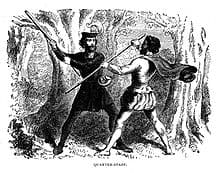
A quarterstaff (plural quarterstaffs or quarterstaves), also short staff or simply staff is a traditional European pole weapon, which was especially prominent in England during the Early Modern period.
The term is generally accepted to refer to a shaft of hardwood from 6 to 9 feet (1.8 to 2.7 m) long, sometimes with a metal tip, ferrule, or spike at one or both ends.
The term “short staff” compares this to the “long staff” based on the pike with a length in excess of 10 to 12 feet (3.0 to 3.7 m). The height of the staff should be around the same as the user plus their hand set upright on their head (approximately 8 inches (20 cm)).
Read More About Quarterstaff / Source
Rough and Tumble
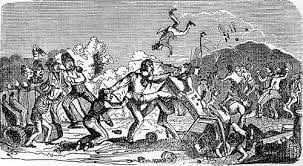
Rough and tumble or gouging was a form of fighting in rural portions of the United States, primarily in the eighteenth and nineteenth centuries. It was often characterized by the objective of gouging out an opponent’s eye but also included other brutally disfiguring techniques, including biting, and typically took place in order to settle disputes. Though gouging was common by the 1730s in southern colonies, the practice was waning by the 1840s, by which time the Bowie knife and revolver had made frontier disputes more lethal.
Though it was never an organized sport, participants would sometimes schedule their fights (as one could schedule a duel), and victors were treated as local heroes. Gouging was essentially a type of duel to defend one’s honor that was most common among the poor, and was especially common in southern states in the late eighteenth and early nineteenth centuries.When a dispute arose, fighters could either agree to fight “fair”, meaning according to Broughton’s rules, or “rough and tumble”. According to Elliott Gorn,
Around the beginning of the nineteenth century, men sought original labels for their brutal style of fighting. “Rough-and-tumble” or simply “gouging” gradually replaced “boxing” as the name for these contests.
Ears, noses, lips, fingers and genitals could be disfigured in these fights, but Gorn notes:
The emphasis on maximum disfigurement, on severing bodily parts, made this fighting style unique. Amid the general mayhem, however, gouging out an opponent’s eye became the sine qua non of rough-and-tumble fighting, much like the knockout punch in modern boxing. The best gougers, of course, were adept at other fighting skills. Some allegedly filed their teeth to bite off an enemy’s appendages more efficiently. Still, liberating an eyeball quickly became a fighter’s surest route to victory and his most prestigious accomplishment.
The practice spread at least as far west as rural Missouri, where “a particularly dextrous fellow could pluck his opponent’s eyeballs from their sockets with one good thrust of the thumbs”. This disfigurement may have been subsequently construed as a visible sign of dishonor. Though the practice was widespread, it was “best suited to the backwoods”, according to Gorn.
As the new style of fighting evolved, its geographical distribution changed. Leadership quickly passed from the southern seaboard to upcountry counties and the western frontier … the settlers of western Carolina, Kentucky, and Tennessee, as well as upland Mississippi, Alabama, and Georgia, became especially known for their pugnacity.
An act passed by the Virginia Assembly in 1752 begins by remarking that “many mischievous and ill disposed persons have of late, in a malicious and barbarous manner, maimed, wounded, and defaced, many of his majesty’s subjects”, then very specifically makes it a felony to “put out an eye, slit the nose, bite or cut off a nose, or lip”, among other offenses. The Assembly went on to amend the act in 1772 to make it clear that this included “gouging, plucking or putting out an eye.” Court cases and legal rulings in Tennessee, South Carolina, and Arkansas provide ample evidence of the history of this type of fighting. Though legend sometimes amplifies the brutality of these fights, Gorn emphasizes the historical reality of these events:
Foreign travelers might exaggerate and backwoods storytellers embellish, but the most neglected fact about eye-gouging matches is their actuality.
Read More About Rough and Tumble / Source
Sanshou

Sanda (Chinese: 散打; pinyin: Sǎndǎ), formerly Sanshou (Chinese: 散手; pinyin: Sǎnshǒu), also known as Chinese boxing or Chinese kickboxing, is the official Chinese full contact combat sport. Sanda is a fighting system which was originally developed by the Chinese military based upon the study and practices of traditional kung fu and modern combat fighting techniques; it combines full-contact kickboxing, which includes close range and rapid successive punches and kicks, with wrestling, takedowns, throws, sweeps, kick catches, and in some competitions, even elbow and knee strikes.Sanda, the free combat, is often taught alongside Wushu Taolu (forms) training. However, as part of the development of sport wushu by the Chinese government, a standard curriculum for Sanda was developed. It is to this standard curriculum that the term Wushu Sanda is usually applied. Sanda may also involve techniques from any other fighting style depending on the teacher’s mode of instruction.
Read More About Sanshou / Source
Savate
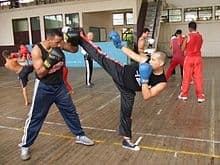
Savate (French pronunciation: [saˈvat]), also known as boxe française, savate boxing, French boxing or French footfighting, is a French kickboxing combat sport that uses the hands and feet as weapons combining elements of English boxing with graceful kicking techniques.Only foot kicks are allowed, unlike some systems such as Muay Thai, which allow the use of the knees or shins. Savate is a French word for “old shoe or boot”. Savate fighters wear specially designed boots. A male practitioner of savate is called a tireur while a female is called a tireuse.
Read More About Savate / Source
Schiwingen
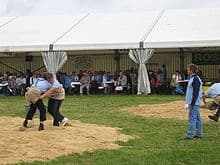
Schwingen (from German schwingen “to swing”), also known as Swiss wrestling (French lutte Suisse) and natively (and colloquially) as Hosenlupf (Swiss German for “breeches-lifting”), is a style of folk wrestling native to Switzerland, more specifically the pre-alpine parts of German-speaking Switzerland. Wrestlers wear Schwingerhosen (“wrestling breeches”) with belts that are used for taking holds. Throws and trips are common because the first person to pin his or her opponent’s shoulders to the ground wins the bout.
Schwingen is considered a “national sport” of Switzerland, alongside Hornussen and Steinstossen. Schwingen and Steinstossen were included as Nationalturnen (“national gymnastics”) in the Eidgenössisches Turnfest at Lausanne in 1855.
The modern history of organized Schwingen tournaments begins with the Unspunnenfest of 1805.
Read More About Schiwingen / Source
Shaolin Kempo Karate
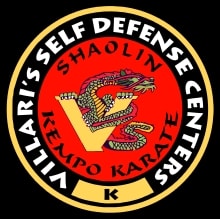
Shaolin Kenpo Karate (or “SKK”) is a martial art style that combines the Five Animals of Shaolin Kung Fu (Shaolinquan), the core competency of Kempo, the hard-hitting linear explosiveness of traditional Karate, as well as the power of Western boxing and the felling and grappling arts of Jujutsu, Chin Na, and Mongolian wrestling. This system was founded and developed by Fredrick J. Villari (a former black belt student of Nick Cerio and William Kwai Sun Chow), who devised a hybrid system which integrated the four ways of fighting: striking, kicking, felling, and grappling to eliminate the inherent weakness of martial arts systems that focus on just one or two of fighting techniques.Shaolin Kenpo Karate is primarily taught through a chain of Villari’s Martial Arts Centers in the United States and Canada, although there are several unaffiliated organizations that teach variations of the style. These include schools founded by former students of Fred Villari.
Read More About Shaolin Kempo Karate / Source
Shindo Jinen Ryu
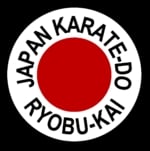
Shindo Jinen Ryu (神道自然流) is a form of karate that was founded in 1933 by Yasuhiro Konishi (康弘小西, Konishi Yasuhiro).
Read More About Shindo Jinen Ryu / Source
Shintaido

Shintaido (新体道, a Japanese word translated as ‘New Body Way’) is a system of movement which aims to use the body as a means of expression and communication. Incorporating both physical and artistic elements, it was created in Japan in the 1960s. Its roots lay in the traditional Japanese martial arts, Chinese medicine and Buddhist meditation techniques, while its creator Hiroyuki Aoki was also influenced by modern Western art and Christianity.
As well as being a practical martial art Shintaido aims to be a form of artistic expression, a healthy exercise, and a path of self-discovery and transformation.Shintaido is practised with bare hands, but the curriculum also includes bojutsu (棒術), involving the use of the long staff (or bō, 棒), and kenjutsu (剣術), using a wooden sword (or bokuto, 木刀).
Read More About Shintaido / Source
Shodokan Aikido
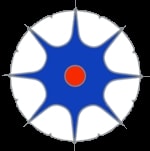
Shodokan Aikido (昭道館合気道, Shōdōkan Aikidō) is the style of Aikido founded by Kenji Tomiki. Shodokan Aikido is sometimes referred to as 合気道競技 (Aikido Kyogi) meaning “Competitive Aikido” or “Sport Aikido” because of its use of regular competitions.
The style itself, could arguably have been founded with the formation of the Waseda University Aikido Club in 1958, although Tomiki didn’t actually name his style Shodokan until 1976. It was in 1967 when Kenji Tomiki established the Shodokan hombu dojo in Osaka, Japan, to teach, train and promote his style. In 1974, Kenji Tomiki found the Japan Aikido Association (NPO Japan Aikido Association). Since it was certified as a specified non-profit organization (NPO corporation) by the Cabinet Office in 2005, the official name was changed to “Specified Non-Profit Organization Japan Aikido Association”. As of 2018, Masako Tomiki is the current chairman of JAA.
Today, Shodokan Aikido is organised with two major groups, the Japan Aikido Association (JAA) and the Shodokan Aikido Federation (SAF).
Read More About Shodokan Aikido / Source
Shootfighting
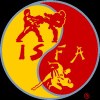
Shootfighting is a martial art and combat sport, with competitions governed by the International Shootfighting Association (ISFA). Shootfighting incorporates techniques from a multitude of traditional martial arts, the most principal of these being wrestling and kenpo.
Shootfighting was previously used synonymously with mixed martial arts competitions in Japan, as opposed to shoot-style professional wrestling competitions. This usage of the term is retired from common usage because it became a registered trademark of Bart Vale, who uses it to describe his hybrid fighting system derived from shoot wrestling. However, it is still sometimes used colloquially.
Examples which were once considered shootfighting styles, tournaments or organizations are Pancrase, Shoot boxing and Shooto, where many fighters still considered themselves to be shootfighters. Ken Shamrock is possibly the most recognisable shoot fighter, as this was the discipline he used during the early days of the UFC.
Read More About Shootfighting / Source
Shooto

Shooto is a combat sport and mixed martial arts organization that is governed by the Shooto Association and the International Shooto Commission. Shooto was originally formed in 1985, first as a particular fighting system and then in 1989 as a mixed martial arts promotion. It is considered one of the first true mixed martial arts competitions, with its Vale Tudo Japan events being essential to the rise of PRIDE Fighting Championships and the development of modern MMA. Many Japanese MMA fighters had their start at Shooto and the organization still helds both professional and amateur tournaments. The list of current and past MMA fighters to come from Shooto roots is quite impressive.
As a fighting system, Shooto is considered a Hybrid martial art derived from Shoot wrestling. It is focused on all aspects of fighting: striking, stand-up grappling and ground fighting. Practitioners are referred to as shooters or shootists. Shooto rules have evolved with time, are different depending on the class, Class C and D are amateur and have more restricted rules more similar to their first events, while professional classes are now true mixed martial arts competitions. Shooto weight classes are different from those of the United States Association of Boxing Commissions, which are used by most MMA promotions.The word shooto is an English transliteration of 修斗 (pronounced shū-to), an ateji derived from the English word “shoot”. The word shooto contains 修 meaning to practice or train in, and 斗 which is just used for its pronunciation, as its literal meaning is a spoon or ladle.
In 2019 Shooto entered into a partnership with ONE Championship. Under the terms of the partnership, Shooto champions will have the opportunity to sign a contract with ONE, while their amateur champions will be given an opportunity to train at Evolve MMA for a year.
Read More About Shooto / Source
Shorinji Kempo
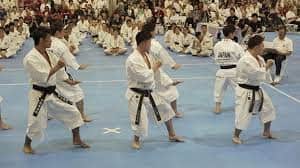
Shorinji Kempo (少林寺拳法, Shōrin-ji kempō, meaning “Shaolin Temple Boxing”) is a Japanese martial art considered to be a modified version of Shaolin Kung Fu. The name Shōrinji Kempo is the Japanese reading of Shàolínsì Quánfǎ. It was established in 1947 by Doshin So (宗 道臣, Sō Dōshin), a Japanese martial artist and former military intelligence agent who lived in China for many years before and during World War II.Shorinji Kempo is a holistic system, whose training methods are divided into three parts: self-defence training, mental training and, health training. The basis are the concepts that “spirit and body are not separable” (心身一如: shinshin-ichinyo) and that it is integral to train both “body and mind as one” (拳禅一如: kenzen ichinyo).
Through employing a well-organized technical course outline, Shorinji Kempo aims to help the practitioner “establish oneself” and to promote “mutual comfort”. The philosophy and techniques of Shorinji Kempo are outlined in their master text, (少林寺拳法教範) Shōrinji-Kempō-kyōhan.
Read More About Shorinji Kempo / Source
Shotokan Karate
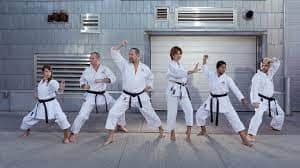
Shotokan (松濤館, Shōtōkan) is a style of karate, developed from various martial arts by Gichin Funakoshi (1868–1957) and his son Gigo (Yoshitaka) Funakoshi (1906–1945). Gichin Funakoshi was born in Okinawa and is widely credited with popularizing “karate do” through a series of public demonstrations, and by promoting the development of university karate clubs, including those at Keio, Waseda, Hitotsubashi (Shodai), Takushoku, Chuo, Gakushuin, and Hosei.Funakoshi had many students at the university clubs and outside dojos, who continued to teach karate after his death in 1957. However, internal disagreements (in particular the notion that competition is contrary to the essence of karate) led to the creation of different organisations—including an initial split between the Japan Karate Association (headed by Masatoshi Nakayama) and the Shotokai (headed by Motonobu Hironishi and Shigeru Egami), followed by many others—so that today there is no single “Shotokan school”, although they all bear Funakoshi’s influence.
As the most widely practiced style, Shotokan is considered a traditional and influential form of karate do.
Read More About Shotokan Karate / Source
Shuai Jiao
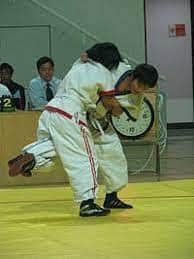
Shuai Jiao (Chinese: 摔跤 or 摔角; pinyin: Shuāijiāo; Wade–Giles: Shuai-chiao) is the term pertaining to the ancient jacket wrestling wushu style of Beijing, Tianjin and Baoding of Hebei Province in the North China Plain which was codified by Shan Pu Ying (善撲营 The Battalion of Excellency in Catching) of the Nei Wu Fu (内務府, Internal Administration Unit of Imperial Household Department). In modern usage it is also the general Mandarin Chinese term for any form of wrestling, both inside and outside China. As a generic name, it may be used to cover various styles of wrestling practiced in China in the form of a martial arts system or a sport. The art was introduced to Southern China in the Republican era (see Republic of China (1912–1949)) after 1911.
Read More About Shuai Jiao / Source
Shuri-ryu
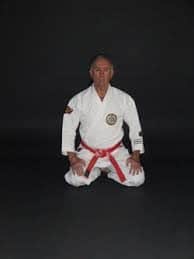
Shuri-ryū (首里流) karate, is an eclectic martial arts system developed by Robert Trias (1923–1989), reportedly the first Caucasian to teach karate in the mainland United States, who opened his public first dojo in 1946 in Phoenix, Arizona. According to modern Shuri-Ryu stylists, Shu which means to learn from tradition, Ri means to transcend or go beyond, and Ryu means any style or particular school of thought (Please see Wikipedia article ShuHaRi). Although according to the Japanese and Okinawan language Shu (首) means head, Ri (里) means Village and Ryu (流) means Style. Later in 1948 he formed the first karate association in the U.S., the United States Karate Association (USKA). The USKA became one of the largest karate associations in the country; its membership included almost all of the early top karate instructors. The style of Shuri-ryū is taught in the United States, parts of Europe, and South America.
Read More About Shuri-ryu / Source
Sibpalki
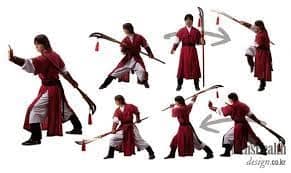
Sibpalki is a Korean martial arts that teaches close combat skills that were utilized in the late 1700s. Sibpalki students practice empty hand techniques and train with martial arts weapons such as sword & shield, staffs, spears, polearms (“spear sword”), etc.
Read More About Sibpalki / Source
Siljun Dobup
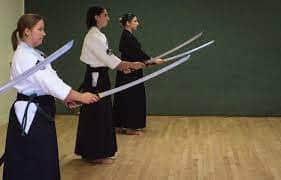
Siljun Dobup is a sword-based martial arts based on a fusion of Japanese and Korean traditions. This martial arts style focuses on developing the skills to use a katana as well as “ki, breathing, flexibility, control of strength and focus”. Unlike Kendo, Siljun Dobup does not involve any sparring. Siljun Dobup is more like Iaido where the student is focused on the drawing, sheathing and cutting of a katana.
Read More About Siljun Dobup / Source
Singlestick
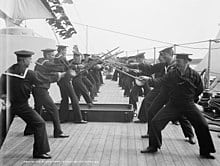
Singlestick is a martial art that uses a wooden stick as its weapon. It began as a way of training soldiers in the use of backswords (such as the sabre or the cutlass). Canne de combat, a French form of stick fighting, is similar to singlestick play, which also includes a self-defense variant with a walking stick.
Read More About Singlestick / Source
Small Circle jujitsu

Small Circle Jujitsu is a style of jujutsu developed by Wally Jay that focuses on employing dual simultaneous push/pull actions and smooth transitions.
Read More About Small Circle jujitsu / Source
Sojutsu

Sōjutsu (槍術), meaning “art of the spear”, is the Japanese martial art of fighting with a Japanese spear (槍, yari).
Read More About Sojutsu / Source
Soo Bahk Do
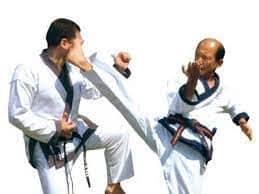
Soo Bahk Do (수박도) is a martial art founded and taught by Kwan Jang Nim Hwang Kee, his successor Hwang Hyun Chul, known as H.C. Hwang, and instructors who are certified by member organizations of the World Moo Duk Kwan, Inc. This martial art was originally the ancient martial art of Korea. Hwang Kee created Moo Duk Kwan with influence from “Soo Bahk Do.”
Read More About Soo Bahk Do / Source
Special Combat Aggresive Reactionary System

Special Combat Aggressive Reactionary Systems (SCARS) is an American combat fighting system created by Jerry L. Peterson.
Read More About Special Combat Aggresive Reactionary System / Source
Spochan

Spochan is a martial arts that uses “air soft” weapons to practice various sword, staff & stick-based fighting techniques. This martial arts “sport” was created by Tetsundo Tanabe. It originated in Japan and has spread to numerous countries around the globe. Spochan is also known as Sport Chanbara.
Read More About Spochan / Source
Ssireum
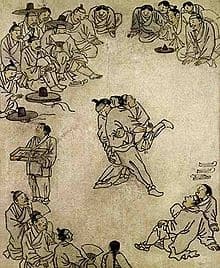
Ssireum (Hangul: 씨름) or Korean wrestling is a folk wrestling style and traditional national sport of Korea that began in the fourth century.
In the modern form each contestant wears a belt (satba) that wraps around the waist and the thigh. The competition employs a series of techniques, which inflict little harm or injury to the opponent: opponents lock on to each other’s belt, and one achieves victory by bringing any part of the opponent’s body above the knee to the ground.
Read More About Ssireum / Source
Sumo

Sumo (Japanese: 相撲, Hepburn: sumō, [sɯmoː], lit. “striking one another”) is a form of competitive full-contact wrestling where a rikishi (wrestler) attempts to force his opponent out of a circular ring (dohyō) or into touching the ground with any body part other than the soles of his feet (usually by throwing, shoving or pushing him down).
Sumo originated in Japan, the only country where it is practiced professionally, where it is considered the national sport. It is considered a gendai budō, which refers to modern Japanese martial arts, but the sport has a history spanning many centuries. Many ancient traditions have been preserved in sumo, and even today the sport includes many ritual elements, such as the use of salt purification, from Shinto.
Life as a wrestler is highly regimented, with rules regulated by the Japan Sumo Association. Most sumo wrestlers are required to live in communal sumo training stables, known in Japanese as heya, where all aspects of their daily lives—from meals to their manner of dress—are dictated by strict tradition.
From 2008 to 2016, a number of high-profile controversies and scandals rocked the sumo world, with an associated effect on its reputation and ticket sales. These have also affected the sport’s ability to attract recruits. Despite this setback, sumo’s popularity and general attendance has rebounded due to having multiple yokozuna (or grand champions) for the first time in a number of years and other high-profile wrestlers grabbing the public’s attention.
Taekwondo
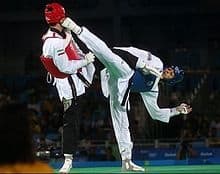
Taekwondo, Tae Kwon Do or Taekwon-Do (; Korean: 태권도/跆拳道 [tʰɛ.k͈wʌn.do] (listen)) is a Korean form of martial arts, characterized by punching and kicking techniques, with emphasis on head-height kicks, jumping spinning kicks, and fast kicking techniques. The literal translation for tae kwon do is “kicking,” “punching,” and “the art or way of.” They are a kind of martial arts in which one attacks or defends with hands and feet anytime or anywhere, with occasional use of weapons. The physical training undertaken in Taekwondo is purposeful and fosters strength of mind through mental armament.Taekwondo practitioners wear a uniform, known as a dobok. It is a combat sport and was developed during the 1940s and 1950s by Korean martial artists with experience in martial arts such as karate, Chinese martial arts, and indigenous Korean martial arts traditions such as Taekkyon, Subak, and Gwonbeop. The oldest governing body for Taekwondo is the Korea Taekwondo Association (KTA), formed in 1959 through a collaborative effort by representatives from the nine original kwans, or martial arts schools, in Korea. The main international organisational bodies for Taekwondo today are the International Taekwon-Do Federation (ITF), founded by Choi Hong Hi in 1966, and the partnership of the Kukkiwon and World Taekwondo (WT, formerly World Taekwondo Federation or WTF), founded in 1972 and 1973 respectively by the Korea Taekwondo Association. Gyeorugi ([kjʌɾuɡi]), a type of full-contact sparring, has been an Olympic event since 2000. The governing body for Taekwondo in the Olympics and Paralympics is World Taekwondo.
Read More About Taekwondo / Source
Tahtib
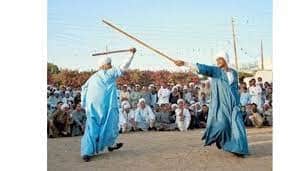
Tahtib (Egyptian Arabic: تحطيب, romanized: taḥṭīb) is the term for a traditional stick-fighting martial art originally named fan a’nazaha wa-tahtib (“the art of being straight and honest through the use of stick”). The original martial version of tahtib later evolved into an Egyptian folk dance with a wooden stick. It is commonly described in English as a “stick dance”, “cane dance”, “stick-dancing game”, or as ritual mock combat accompanied by music. Nowadays, the word tahtib encompasses both martial practice and performance art. It is mainly practiced today in Upper Egypt. Tahtib is regularly performed for tourists in Luxor and Aswan.The stick used in tahtib is about four feet in length and is called an asa, asaya, assaya, or nabboot. It is often flailed in large figure-eight patterns across the body with such speed that the displacement of air is loudly discernible.
Read More About Tahtib / Source
Thai Chi
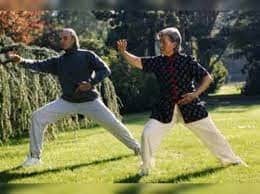
Tai chi (simplified Chinese: 太极; traditional Chinese: 太極; pinyin: Tàijí), short for T’ai chi ch’üan or Tàijíquán (太極拳), sometimes also known as “Shadowboxing”, is an internal Chinese martial art practiced for defense training, health benefits, and meditation. Tai chi has practitioners worldwide.
Yang Shaohou, Yang Chengfu, Wu Chien-ch‘üan and Sun Lutang promoted the art for its health benefits beginning in the early 20th century. Its global following often for its benefit to personal health.Many forms are practiced, both traditional and modern. Most modern styles trace their development to the five traditional schools: Chen, Yang, Wu (Hao), Wu, and Sun. All trace their historical origins to Chen Village.
Read More About Thai Chi / Source
Thoda

Thoda, the impressive martial art form of Himachal Pradesh, relies on one’s archery prowess, dating back to the days of the Mahabharata, when bows and arrows were used in the epic battles, between the Pandavas and the Kauravas, residing in the picturesque valleys of Kulu and Manali. Thus, this martial art has its origin in Kulu. Thoda, the name is derived, from the round piece of wood fixed to the head of the arrow, which is used to blunt its wounding potential.
Read More About Thoda / Source
To-Shin Do
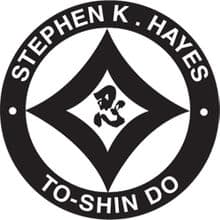
To-Shin Do is a martial art founded by Black Belt Hall of Fame instructor Stephen K. Hayes in 1997. It is a modernized version of ninjutsu, and differs from the traditional form taught by Masaaki Hatsumi’s Bujinkan organization. Instruction focuses on threats found in contemporary western society. In addition to hand-to-hand combat skills, students are exposed to: methods for survival in hostile environments, security protection for dignitaries, how to instruct classes and run a school, classical Japanese weapons, meditation mind science, and health restoration yoga. The headquarters school (hombu) is located in Dayton, Ohio, USA.
Read More About To-Shin Do / Source
US Arny's Morden Army Combatives Program

Combatives is the term for hand-to-hand combat training and techniques within the Army branch of the United States military.
Read More About US Arny's Morden Army Combatives Program / Source
Vajra Mushti

Vajra-musti (Sanskrit:वज्रमुष्टि, “thunder fist” or “diamond fist”) refers to a “fist-load, knuckleduster-like” weapon and also a form of Indian wrestling in which the weapon is employed. The weapon is sometimes called Indra-musti which means Indra’s fist.
The vajramusti is usually made of ivory or buffalo horn. Its appearance is that of a knuckleduster, slightly pointed at the sides and with small spikes at the knuckles. The variation used for warfare had long blades protruding from each end, and an elaborate bladed knuckle.
Read More About Vajra Mushti / Source
Varma Kalai
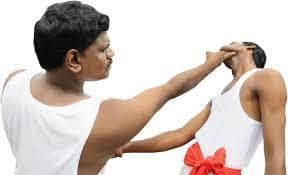
Varma Kalai (Tamil: varmakkalai, Malayalam and Sanskrit: marma-vidya, Sinhala: maru kalā, Telugu: marma-vidya kaḷa) is an Indian traditional art of vital points. It originated in present-day kanyakumari, Tamil Nadu. It combines massage, alternative medicine, traditional yoga and martial arts in which the body’s pressure points (varmam) are manipulated to heal or cause harm. The healing application called Vaidhiya Murai is part of Siddha medicine (siddha vaidyam).Its combat application is known as Adimurai (it includes a component called Varma Adi, meaning “pressure-point striking”) can be done either empty-handed or with a blunt weapon such as a stick or staff. Varma Kalai is usually taught in the advanced stage of Adimurai, Kalaripayattu, and Silambam in Kerala and Tamil Nadu respectively; strikes are targeted at the nerves, veins, tendons, soft tissues or ligaments, organs and bone joints.
Read More About Varma Kalai / Source
Vovinam
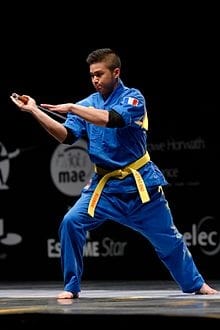
Vovinam (short for Võ Việt Nam; literally meaning Vietnamese Martial Arts, or Vietnamese: Việt Võ Đạo (越武道), meaning Vietnamese Way of Martial Arts) is a Vietnamese martial art,
It was founded in 1938 by Nguyễn Lộc. It is based on traditional Vietnamese subjects.
Vovinam involves the use of the hands, elbows, legs, knees and weapons such as swords, knives, chisels, claws, fans. Students also learn how to deal with hand-held weapons, counter-attacks, lock-ups, and levers. Amongst Vietnamese martial arts, Vovinam is the largest and most developed in Vietnam with more than 60 schools around the world, including Poland, Belgium,
Canada, Cambodia, Denmark, Germany, the United States, Morocco, Norway, Russia, France, Romania, Switzerland, Sweden, Singapore, Uzbekistan, Thailand, Italy, Australia, India, Pakistan, Iran, Spain, Algeria, Taiwan, Greece. The Chief of Vovinam Council now is Nguyễn Văn Chiếu.Vovinam is practiced with and without weapons. It is based on the principle of between hard and soft. It includes training of the body as well as the mind. It uses force and reaction of the opponent. Vovinam also includes hand, elbow, kicks, escape- and levering techniques. Both attack and defense techniques are trained, as well as forms, combat and traditional wrestling.
The wide range of techniques include punching, kicking, forms, wrestling, sword, staff, axe, folding fan and others.
Self-defense techniques cover defense against weaponless attacks like choking from behind and defense against attackers armed with knives or swords. Advanced students learn to combine the techniques and defend themselves against armed opponents. Instructors teach traditional weapons like the long stick, short stick, knife, sword and sabre. The weapons thus serve as training devices for reaching optimal control of body and mind.
Read More About Vovinam / Source
Wing Chun

Wing Chun Kuen (Chinese: 咏春拳), commonly known as Wing Chun (Chinese: 詠春), or Ving Tsun, is a concept-based traditional Southern Chinese kung fu (wushu) style and a form of self-defense, that requires quick arm movements and strong legs to defeat opponents. Softness (via relaxation) and performance of techniques in a relaxed manner is fundamental to Wing Chun.
Read More About Wing Chun / Source
Won Hwa Do

Won Hwa Do (or WonHwaDo) is a Korean martial arts known for its circular techniques. Within this circular philosophy, this martial arts style utilizes forms, strikes, kicks, throws, joint locks and submission techniques. In fact, Won Hwa Do’s name means “The Way of Circular Harmony”. Some practitioners think Won Hwa Do is like a combination of Korean Hapkido and Japanese Aikido. This Korean martial arts style was founded in 1972 by Great Grand Master Han Bong Ki.
Read More About Won Hwa Do / Source
Yaw-Yan
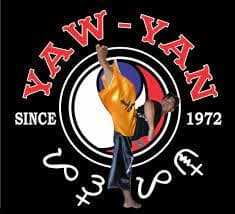
Yaw-Yan, also called Sayaw ng Kamatayan, Filipino Martial art and Dance of Death, is a Filipino style of Kickboxing developed by Napoleon A. Fernandez and based on older Filipino martial arts.
Since its inception in the 1970s, it has dominated the kickboxing scene in the Philippines and has proven very effective against other stand-up fighting arts.
Yaw-Yan closely resembles Muay Thai, but differs in the hip-torquing motion as well as the downward-cutting nature of its kicks, and the emphasis on delivering attacks from long range (while Muay Thai focuses more on clinching).
Yaw-yan practitioners participate in various Filipino mixed-martial arts tournaments such as the Universal Reality Combat Championship and Fearless Fighting.
Read More About Yaw-Yan / Source
Yosekian Budo
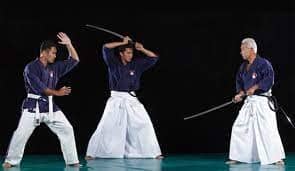
Yoseikan budō (養正館武道) (originally Yoseikan Ryu Gyokushin Jujutsu) may be classified as a sōgō budō form (総合武道, “composite” or “comprehensive” martial art), but is used here to indicate a martial art into which various martial ways have been integrated. It is probably most widely known for its descent from a pre-war style of aikido; however, it has important connections to judo, karate, western boxing, savate, and a traditional forms of Japanese combat known as gyokushin-ryū jujutsu and Tenshin Shōden Katori Shintō-ryū.
The name of the art yō-sei-kan is derived from three Japanese characters, yō meaning ‘teaching’, sei meaning “truth”, kan meaning “place”, which may be translated roughly into English as “the place where the truth is taught” or alternately “place for practising what is right”. The intent of the name was not to assert an exclusive possession of the truth regarding the martial arts but rather to describe how the comprehensive nature of the Yoseikan training environment allows an individual to discover their own sense of “truth” by studying a wide range of differing martial techniques, philosophies and principles.
Yoseikan budō originated in 1931 as the style created by its founder Minoru Mochizuki (1907–2003), a high ranking student and assistant to Kanō Jigorō, the founder of judo, and Morihei Ueshiba, the founder of aikido, in the pre-World War II period. In addition to the very high ranks he held in these arts he was student of one of the oldest styles of traditional Japanese koryū budō, the Katori Shintō-ryō, and studied with various karate teachers including Gichin Funakoshi, the man who brought karate from the Okinawan islands to mainland Japan.
Read More About Yosekian Budo / Source
Zulu Stick Fighting

Zulu stick fighting (or Nguni stick fighting) is a South African weapon-based martial arts. This African martial arts is also known as Donga (or “playing sticks”). Zulu stick fighting uses one stick for attack and one stick for defense. Some forms of this martial arts also use a shield for defense.
Read More About Zulu Stick Fighting / Source
Dim Mak
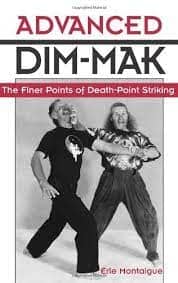
The touch of death (or death-point striking) refers to any martial arts technique reputed to kill using seemingly less than lethal force targeted at specific areas of the body.
The concept known as dim mak (simplified Chinese: 点脉; traditional Chinese: 點脈; pinyin: diǎnmài; Jyutping: dim2 mak6; lit. ‘press artery’), alternatively diǎnxué (simplified Chinese: 点穴; traditional Chinese: 點穴) traces its history to traditional Chinese medicine acupuncture. Tales of its use are often found in the Wuxia genre of Chinese martial arts fiction. Dim mak is depicted as a secret body of knowledge with techniques that attack pressure points and meridians, said to incapacitate or sometimes cause immediate or even delayed death to an opponent. Little scientific or historical evidence exists for a martial arts “touch of death”, although it has been confirmed that trauma may cause disproportionately catastrophic consequences when applied to known pressure points under specific circumstances. Commotio cordis, for example, is an often lethal disruption of heart rhythm that occurs as a result of a blow to the area directly over the heart (the precordial region), at a critical time during the cycle of a heart beat causing cardiac arrest.
The concept known as vibrating palm originates with the Chinese martial arts Neijing (“internal”) energy techniques that deal with the qi energy and the type of force (jin) used. It is depicted as “a technique that is part psychic and part vibratory, this energy is then focused into a wave”.
Read More About Dim Mak / Source
Jeet Kune Do
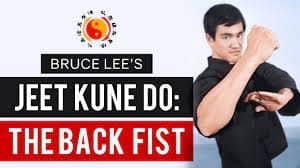
Jeet Kune Do is a hybrid martial art heavily influenced and adapted by the personal philosophy and experiences of martial artist Bruce Lee.
Read More About Jeet Kune Do / Source




